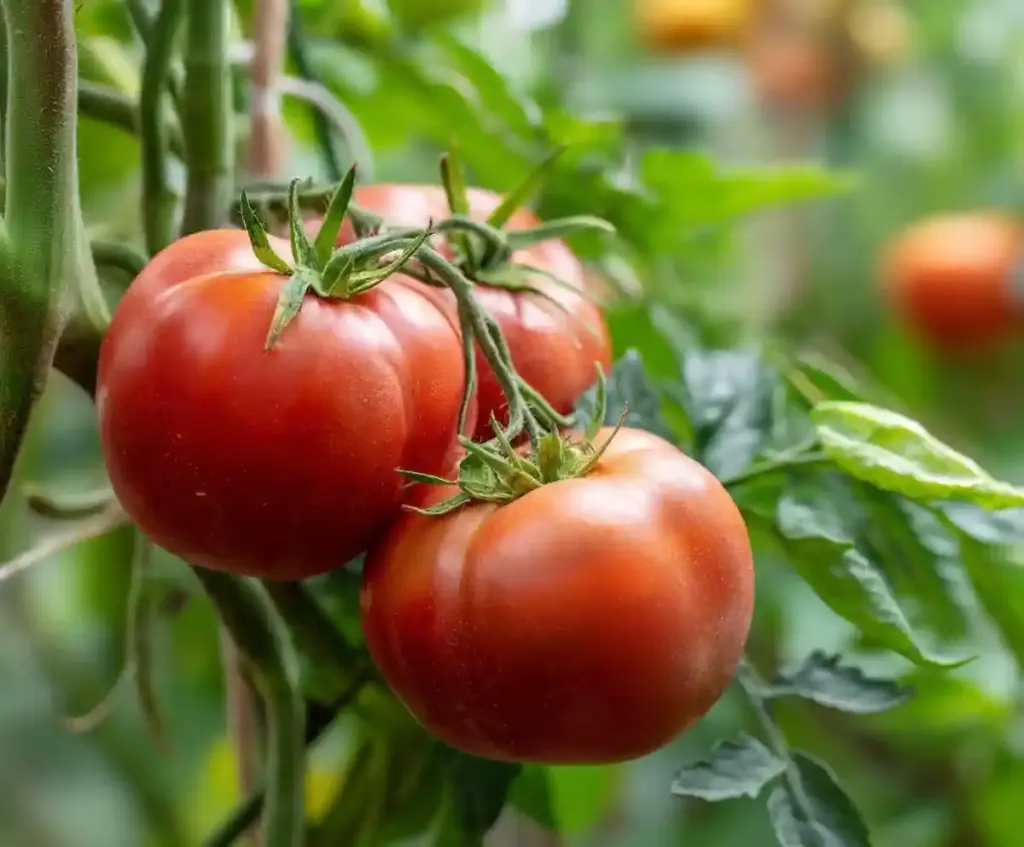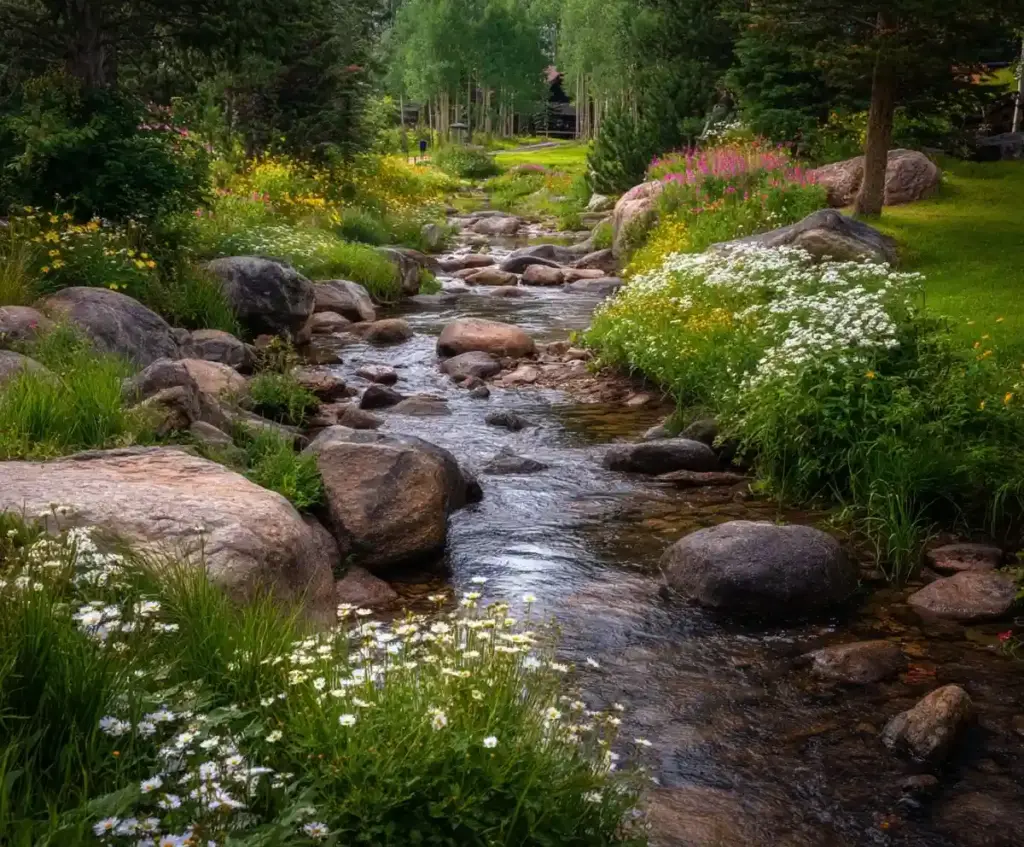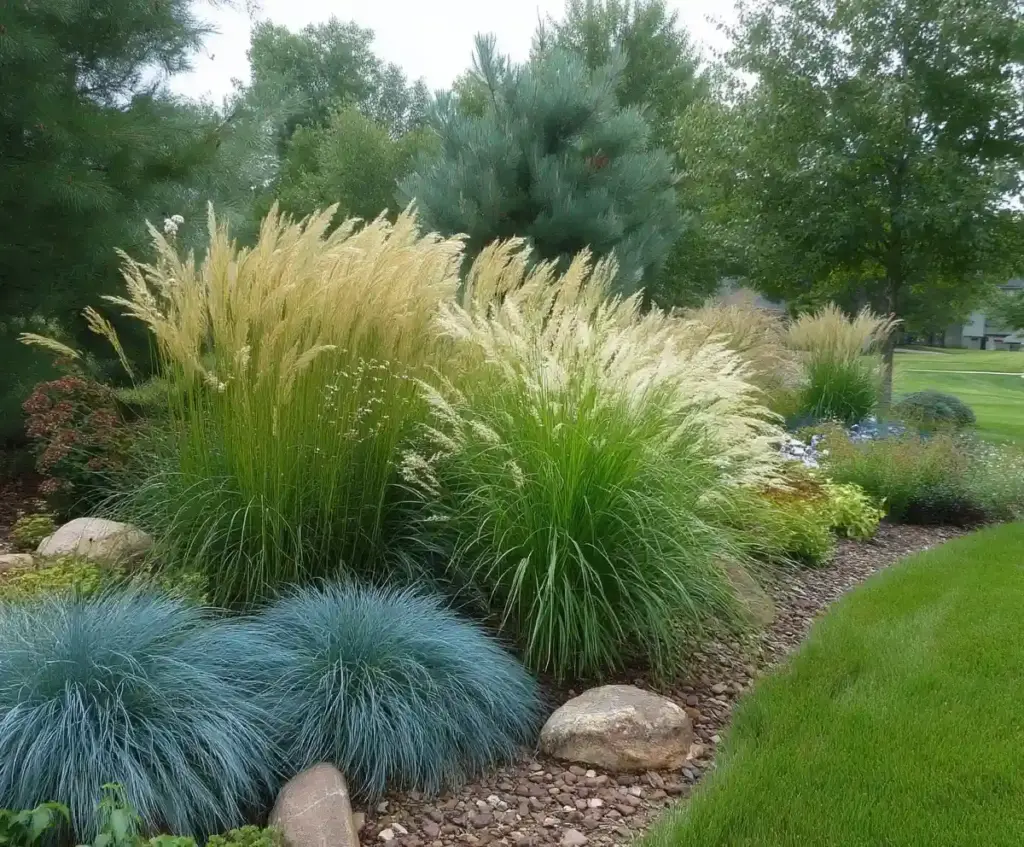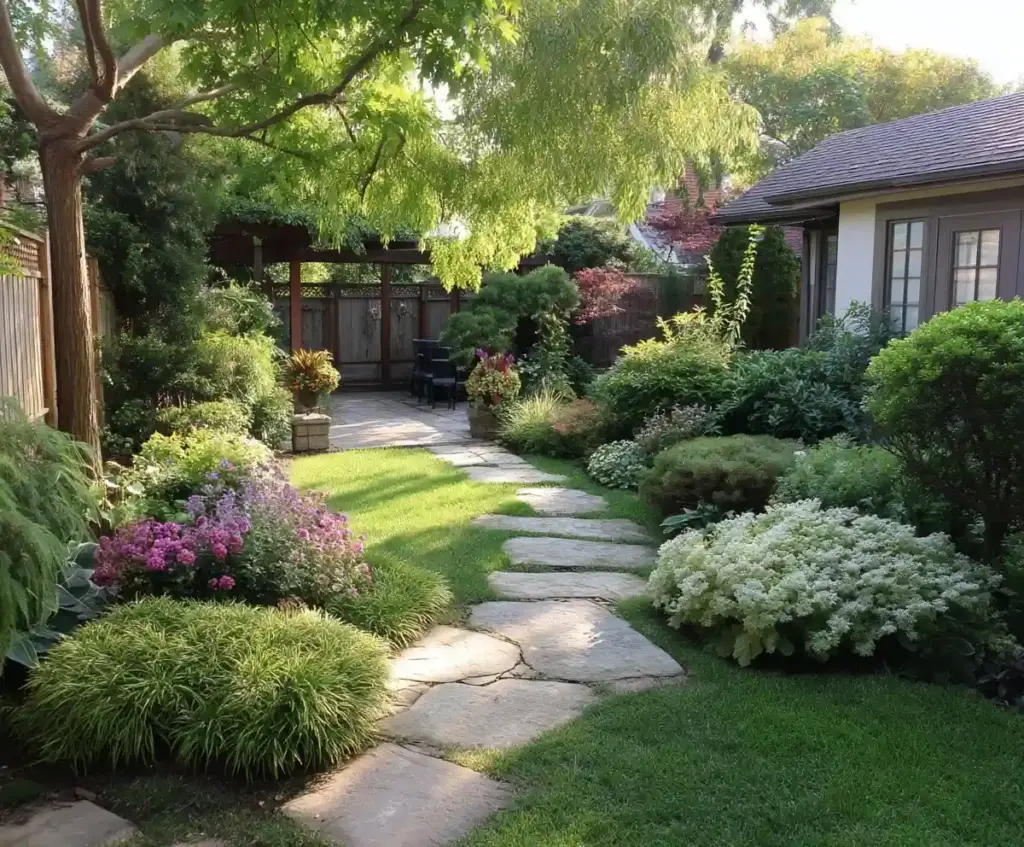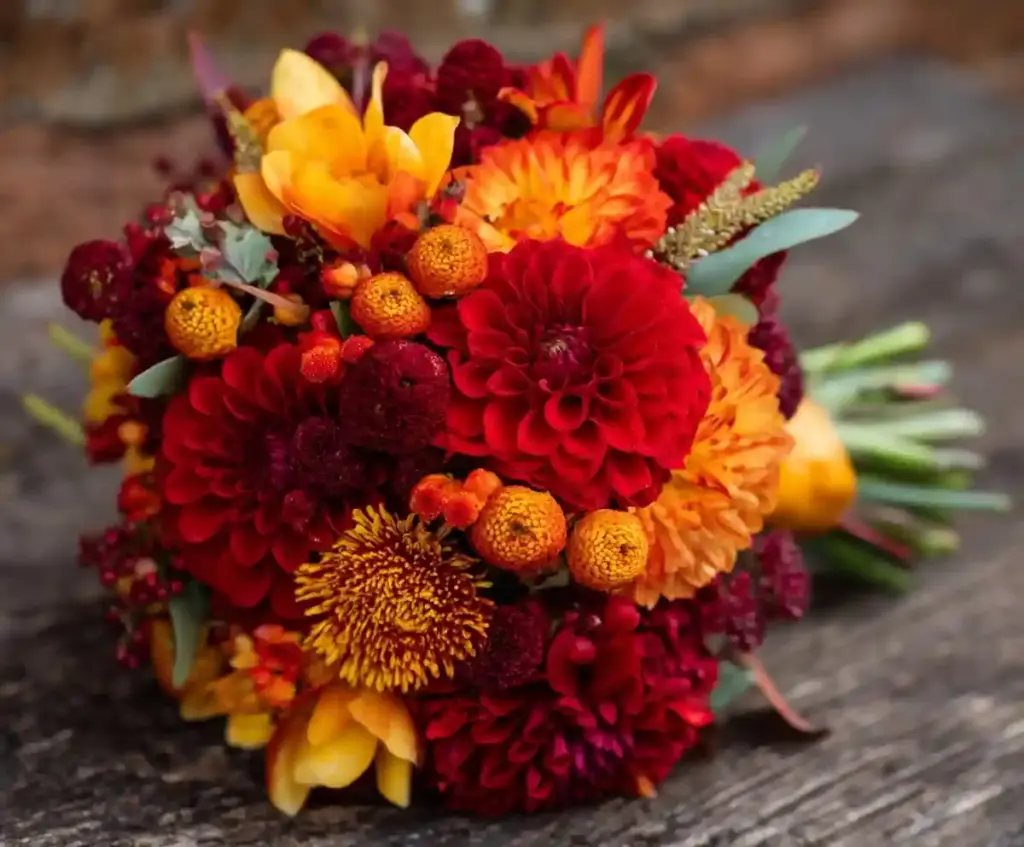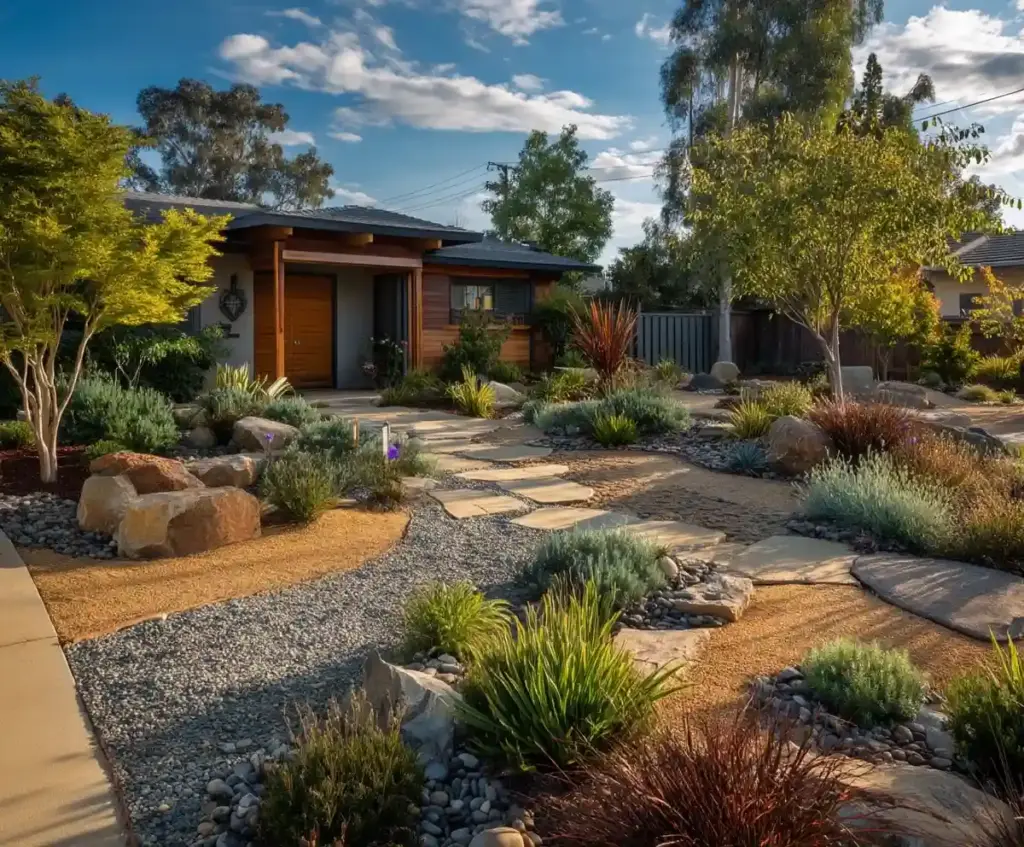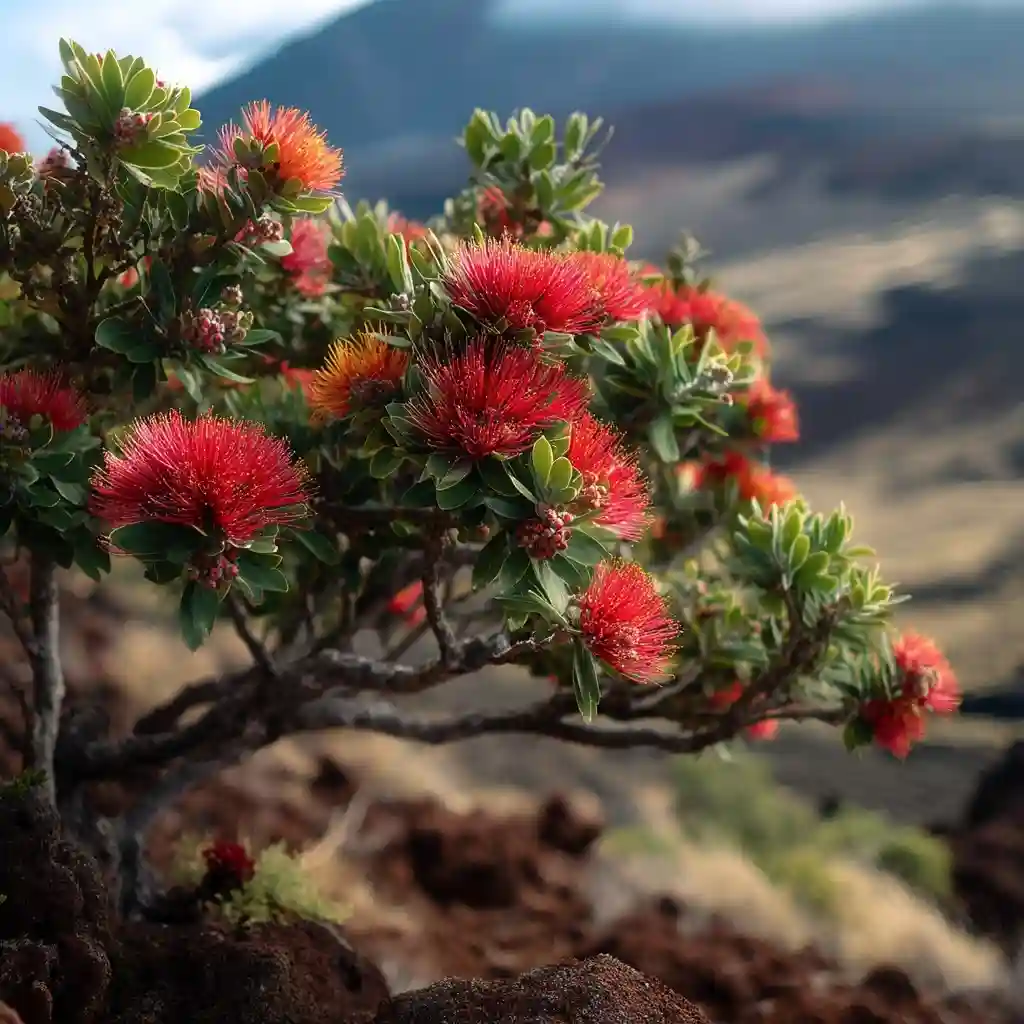Best Hawaiian Flowers capture the essence of the islands’ natural beauty, turning every garden, lei, and landscape into a living postcard. Hawaii is home to a spectacular variety of blossoms, many of which are found nowhere else on Earth. These flowers are more than just eye-catching—they carry cultural significance, appear in traditional ceremonies, and are symbols of the Aloha spirit. From the vibrant hues of hibiscus to the unique shape of the Silversword, Hawaiian flowers enchant travelers and locals alike.
This guide highlights 26 of the best Hawaiian flowers, offering a glimpse into their beauty, uniqueness, and importance. Whether you’re planning to visit Hawaii, enhance your tropical garden, or simply admire rare blooms, this list will introduce you to some of the most breathtaking species the islands have to offer.
Table of Contents
1. Metrosideros polymorpha (ʻŌhiʻa Lehua)
The ʻŌhiʻa Lehua is one of the best Hawaiian flowers and an iconic symbol of the islands. Known for its fiery red blossoms, this native flower often carpets Hawaii’s volcanic landscapes, bringing color to even the starkest lava fields. It thrives in a variety of elevations, from coastal areas to mountain slopes, showcasing its resilience and adaptability.
In Hawaiian culture, the ʻŌhiʻa Lehua is deeply tied to legends of love and transformation. Its vibrant blooms are often used in traditional leis, and the tree itself plays an essential role in local ecosystems by providing nectar for native birds like the ‘i‘iwi. Gardeners love this plant for its striking color and hardiness, making it a favorite for those recreating a tropical paradise.
2. Sesbania tomentosa (Oahu River Hemp)
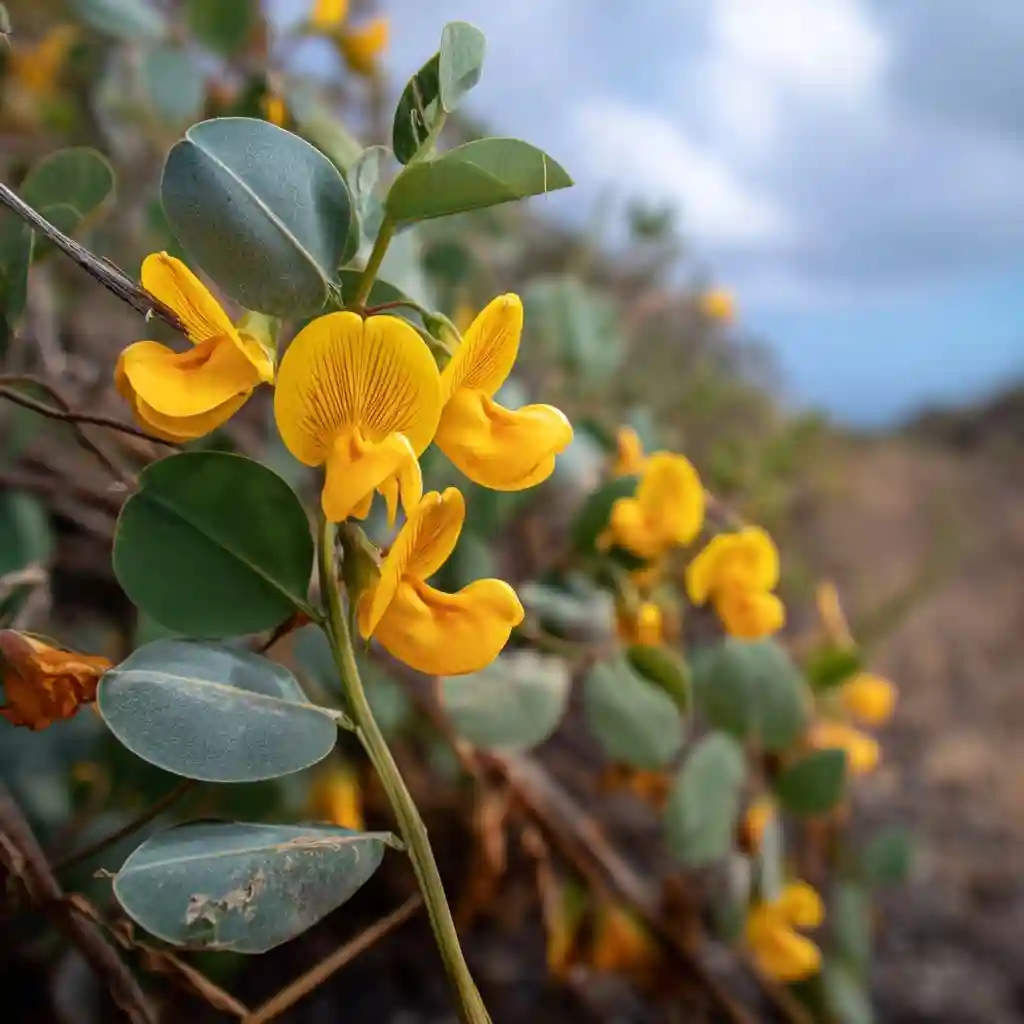
The Oahu River Hemp, or Sesbania tomentosa, is a rare and beautiful native plant that earns its spot among the best Hawaiian flowers. Featuring clusters of bright red to orange pea-like blossoms, this flowering shrub adds a bold splash of color to Hawaii’s dry coastal regions and sandy soils.
Beyond its beauty, Sesbania tomentosa plays an important ecological role. It helps stabilize soil in fragile coastal ecosystems and provides nectar for native pollinators, including Hawaiian bees and butterflies. Because this plant is considered endangered, it is highly valued in restoration projects and native landscaping.
Gardeners seeking to grow this flower should mimic its natural environment—dry, well-draining soil and plenty of sun. Its brilliant blooms and environmental benefits make it a meaningful addition to any Hawaiian-inspired garden.
3. Argemone glauca (Pua Kala)
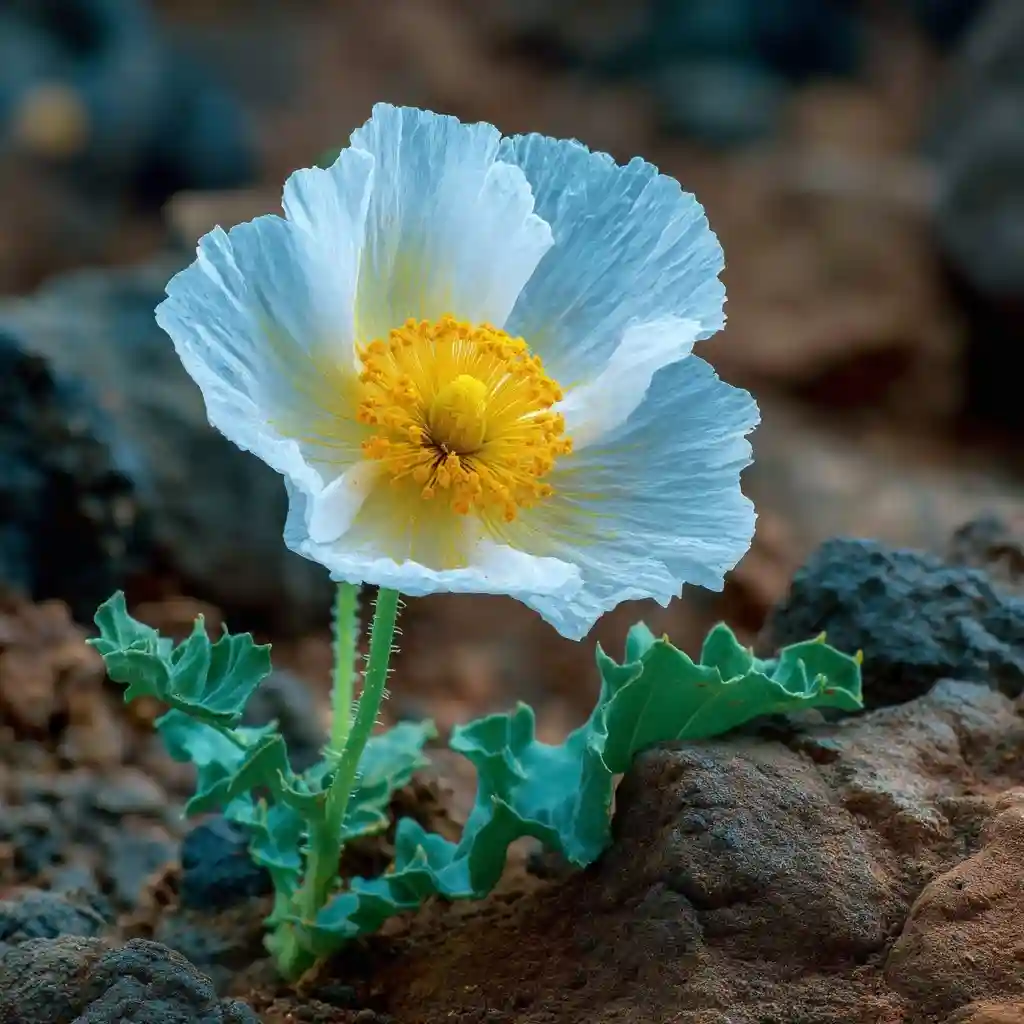
The Pua Kala, scientifically known as Argemone glauca, is a striking white poppy native to Hawaii and is celebrated as one of the best Hawaiian flowers. Its delicate, papery petals contrast beautifully with its spiny green foliage, creating a unique look that immediately stands out in the wild.
Pua Kala thrives in dry, rocky areas and is highly drought-tolerant, making it an important part of Hawaii’s arid ecosystems. While it appears fragile, this hardy plant is well-adapted to challenging environments and often blooms where few other flowers can survive.
Cultural significance surrounds the Pua Kala as well. Traditionally, Hawaiians recognized the plant for its medicinal properties, though its thorny stems and milky sap require careful handling. For home gardens, it adds an exotic, low-maintenance touch when planted in sunny, well-drained locations.
4. Abutilon eremitopetalum
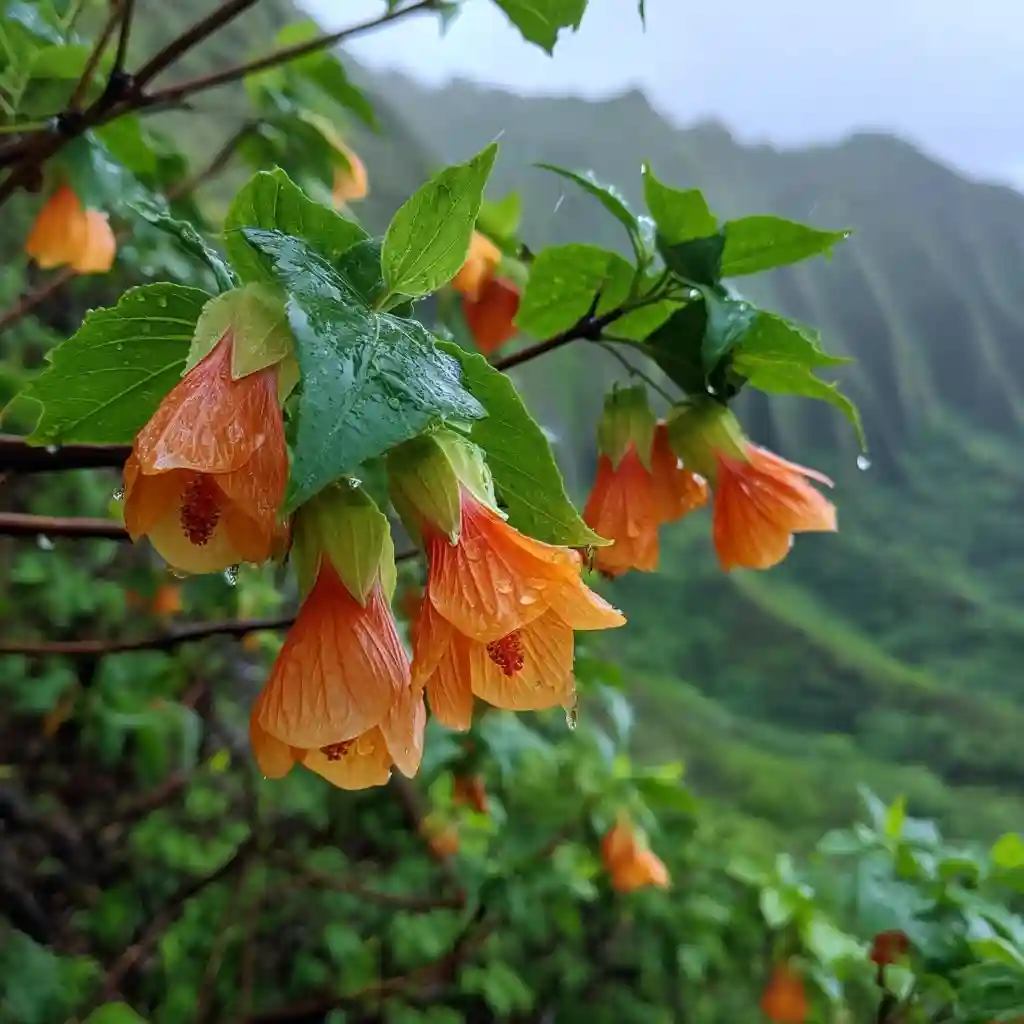
Abutilon eremitopetalum is a rare and captivating native shrub that secures its place among the best Hawaiian flowers. Known for its delicate, bell-shaped yellow flowers, this plant is endemic to the dry forests of Lana‘i, where it contributes to the unique biodiversity of the island.
This flowering shrub features soft, velvety leaves and blooms that attract local pollinators, including Hawaiian bees. Because of its limited natural habitat, it is considered endangered and is often part of conservation efforts aimed at preserving Hawaii’s native flora.
For gardeners, Abutilon eremitopetalum is best suited to warm, sunny environments with excellent drainage. When cultivated responsibly, it adds a gentle tropical touch to native plant gardens while supporting local ecosystems.
5. Geranium arboreum
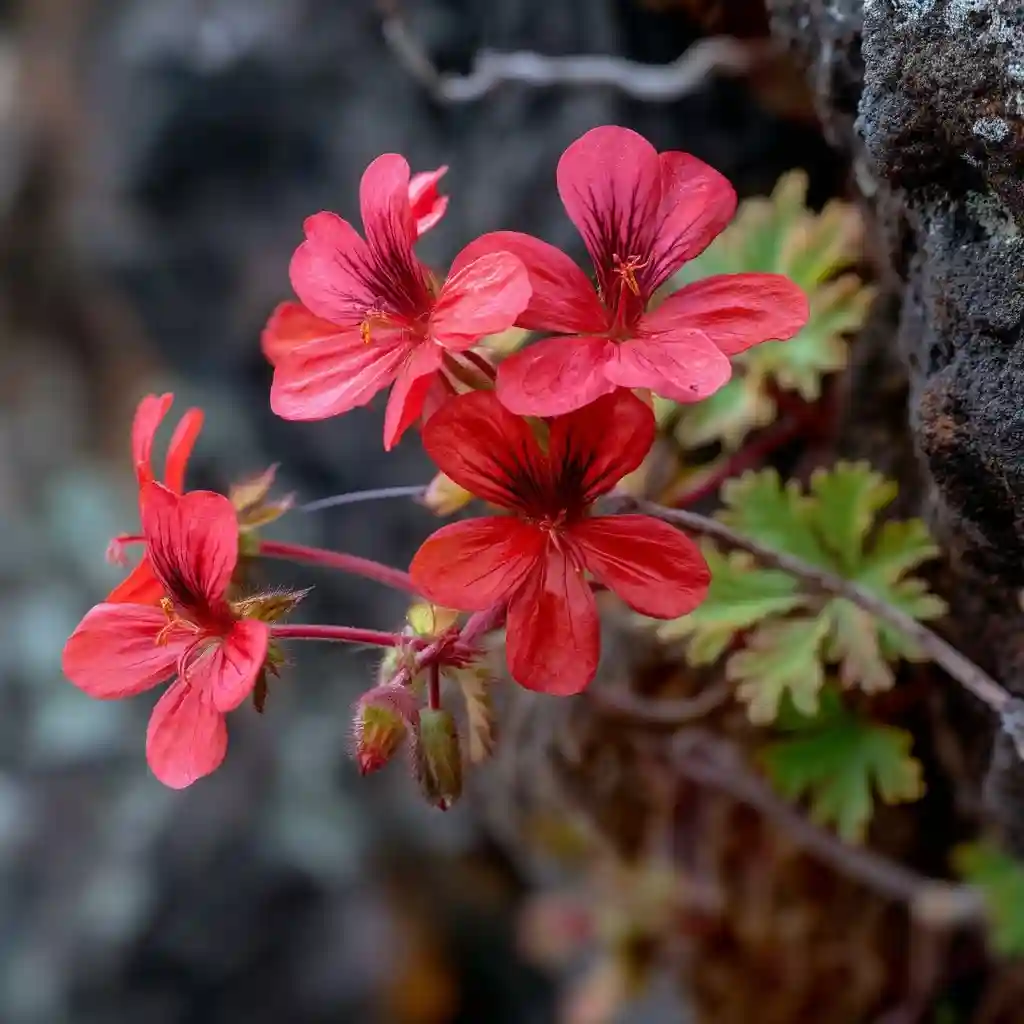
Geranium arboreum, often referred to as the Hawaiian red geranium, is a rare shrub that stands out as one of the best Hawaiian flowers. Unlike the common geraniums seen in mainland gardens, this species is endemic to Hawaii and showcases vibrant clusters of red blooms that brighten rocky slopes and dry forest areas.
This unique flower plays a key role in supporting native pollinators. Its blossoms attract Hawaiian honeycreepers, while its hardy nature allows it to thrive in the islands’ rugged environments.
Because Geranium arboreum is considered endangered, it is primarily seen in protected areas and conservation gardens. For gardeners with a passion for native species, cultivating this plant under the right conditions not only brings vivid color to the landscape but also contributes to preserving Hawaii’s botanical heritage.
6. Hibiscus brackenridgei (Hawaiian Yellow Hibiscus)
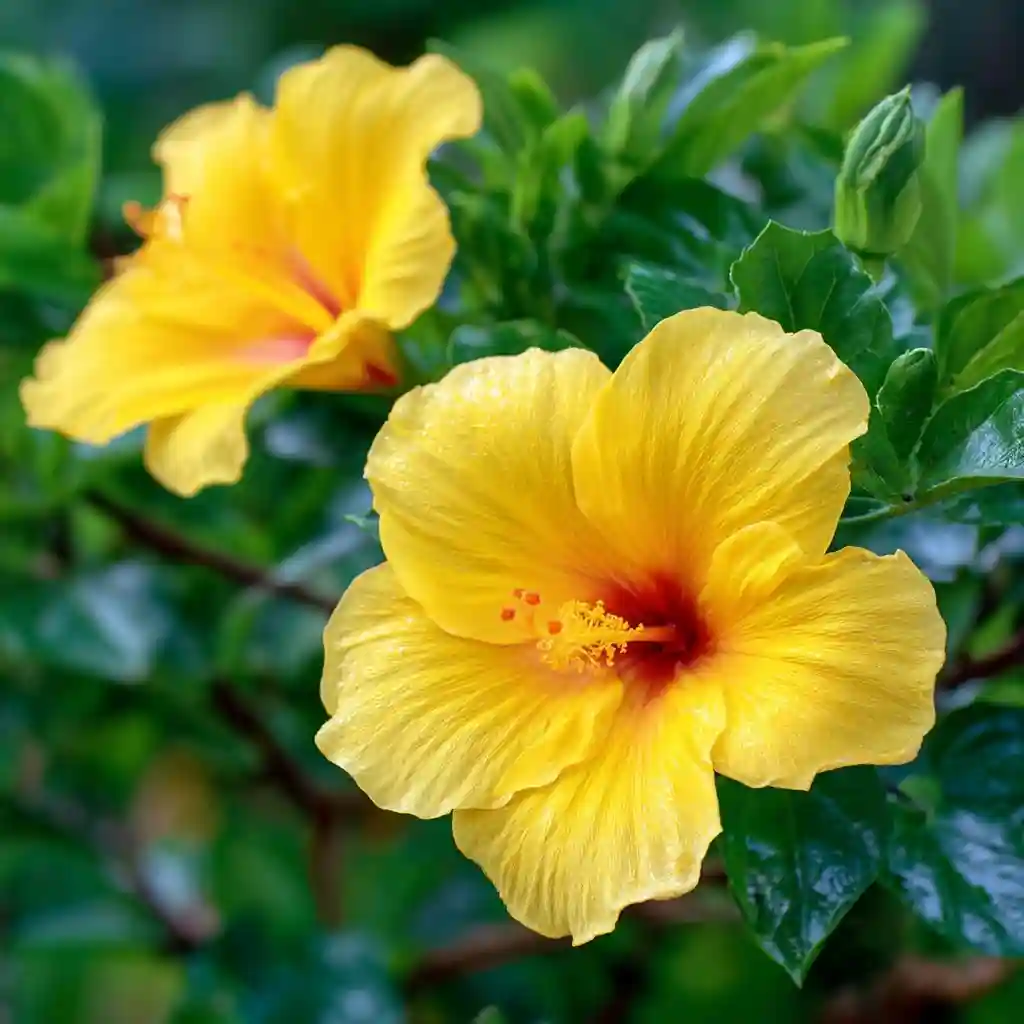
Hibiscus brackenridgei, widely celebrated as the Hawaiian Yellow Hibiscus, holds the honor of being Hawaii’s official state flower and is a shining example of the best Hawaiian flowers. Its bright, golden-yellow petals and striking stamens bring instant tropical charm, making it a beloved symbol of the islands.
This hibiscus species thrives in sunny, dry areas across multiple Hawaiian islands, often on rocky slopes or shrublands. Its showy blooms not only enhance landscapes but also provide nectar for native insects and birds.
Gardeners prize Hibiscus brackenridgei for its beauty and symbolism. While it requires full sun and well-drained soil, this plant rewards care with abundant, eye-catching flowers. Incorporating this species into a Hawaiian-inspired garden brings both aesthetic appeal and a connection to the islands’ cultural heritage.
7. Bidens cosmoides
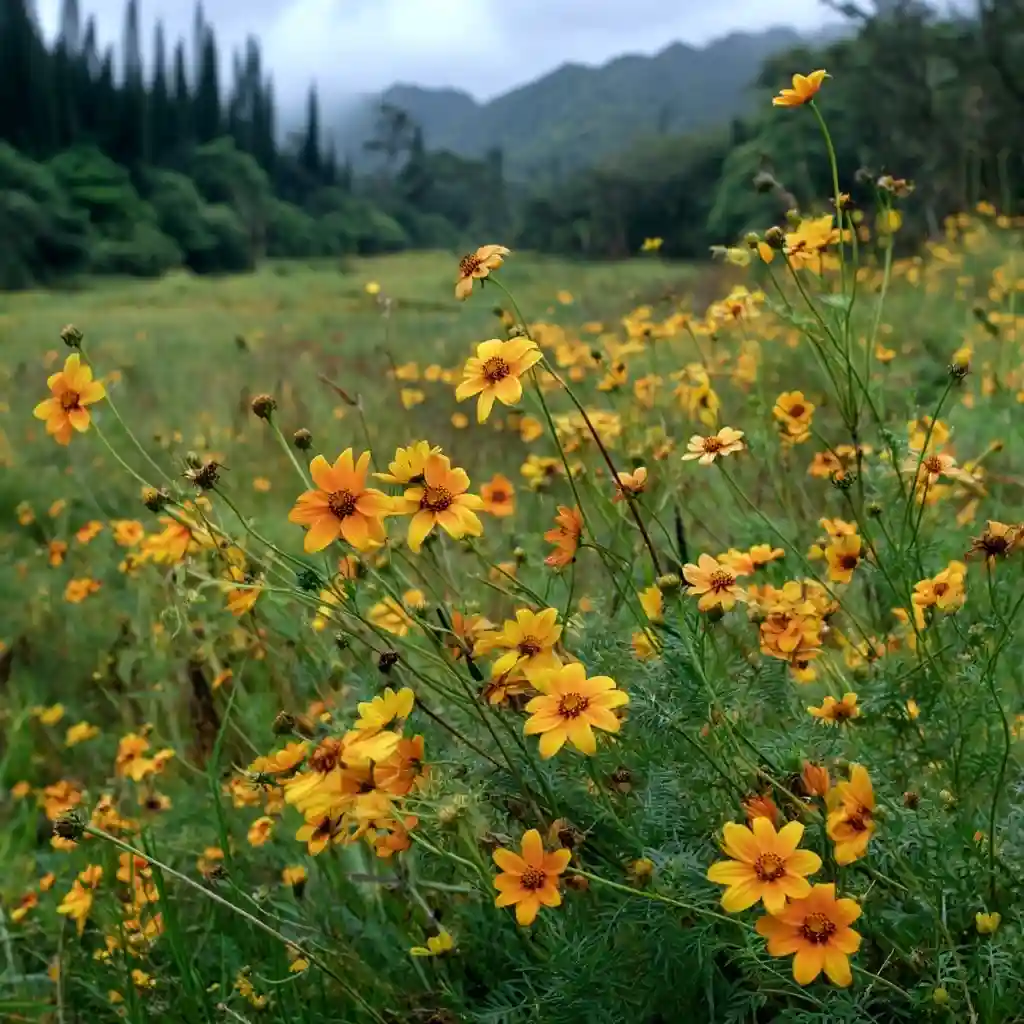
Bidens cosmoides, often called cosmos beggarticks, is a vibrant and rare species that easily earns a place among the best Hawaiian flowers. With its large, daisy-like yellow to orange blooms, this flower brings a cheerful burst of color to the islands’ natural landscapes.
Native to Hawaii, Bidens cosmoides thrives in sunny, dry areas and is especially valued for its role in supporting local pollinators. Its blossoms attract bees and butterflies, helping maintain the delicate balance of native ecosystems.
For gardeners, this plant is a low-maintenance gem. When provided with full sun and well-drained soil, Bidens cosmoides produces brilliant flowers that brighten both native gardens and tropical landscapes, all while contributing to pollinator conservation.
8. Brighamia insignis (Cabbage on a Stick)
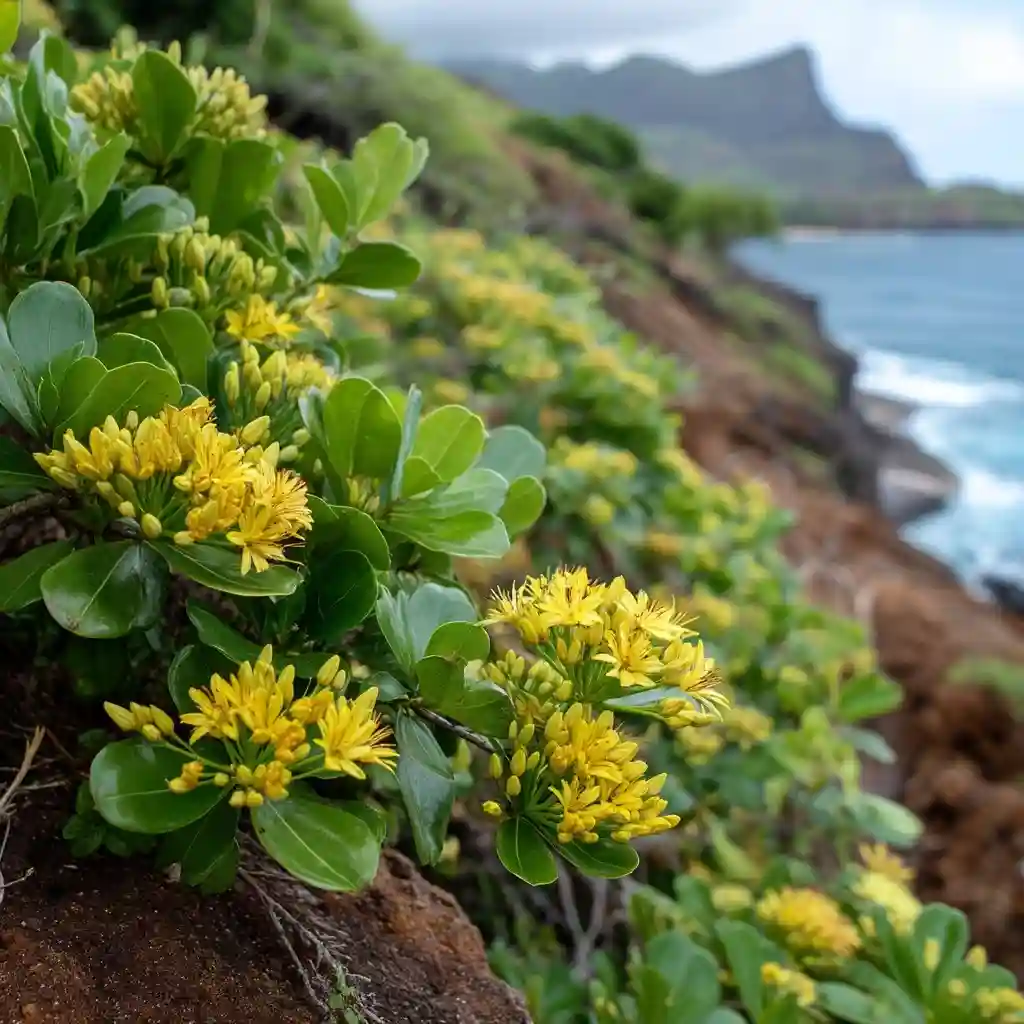
Brighamia insignis, famously nicknamed “Cabbage on a Stick,” is one of the most distinctive and best Hawaiian flowers. This critically endangered plant features a thick, cabbage-like stalk topped with clusters of creamy yellow, star-shaped blooms that release a sweet fragrance in the evenings.
Endemic to Hawaii, Brighamia insignis naturally grows on steep coastal cliffs, making it a rare sight in the wild. Its unique appearance and resilience have made it a symbol of Hawaiian plant conservation efforts.
In gardens or botanical collections, it thrives best in well-draining soil, warm climates, and partial sun. When cultivated responsibly, it not only adds an exotic touch but also serves as a reminder of the importance of protecting Hawaii’s rare and native species.
9. Sophora chrysophylla (Māmane)
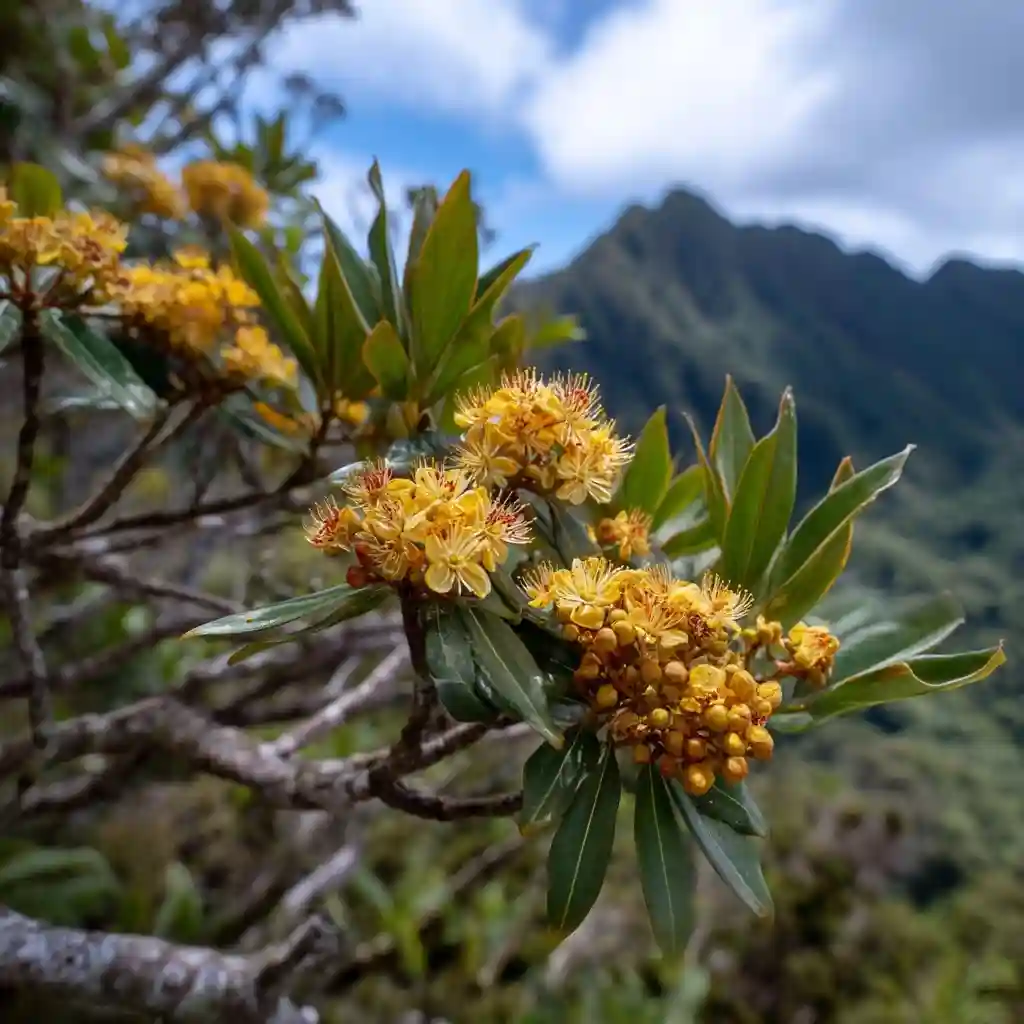
Sophora chrysophylla, commonly known as Māmane, is a native Hawaiian tree that proudly ranks among the best Hawaiian flowers. This small to medium-sized tree produces clusters of bright yellow, pea-shaped blossoms that bring life to the dry forests and high mountain slopes of Hawaii.
Beyond its beauty, Māmane is ecologically vital. Its seeds and flowers provide food for the endangered Hawaiian honeycreeper, the palila bird, making it a keystone species in its natural habitat. The tree also helps stabilize soil in upland regions, supporting the islands’ fragile ecosystems.
For gardeners, cultivating Māmane can be rewarding if provided with full sun and well-draining soil. Its sunny blossoms and ecological benefits make it a perfect choice for those aiming to support wildlife while adding authentic Hawaiian charm to their landscape.
10. Broussaisia arguta (Kanawao)
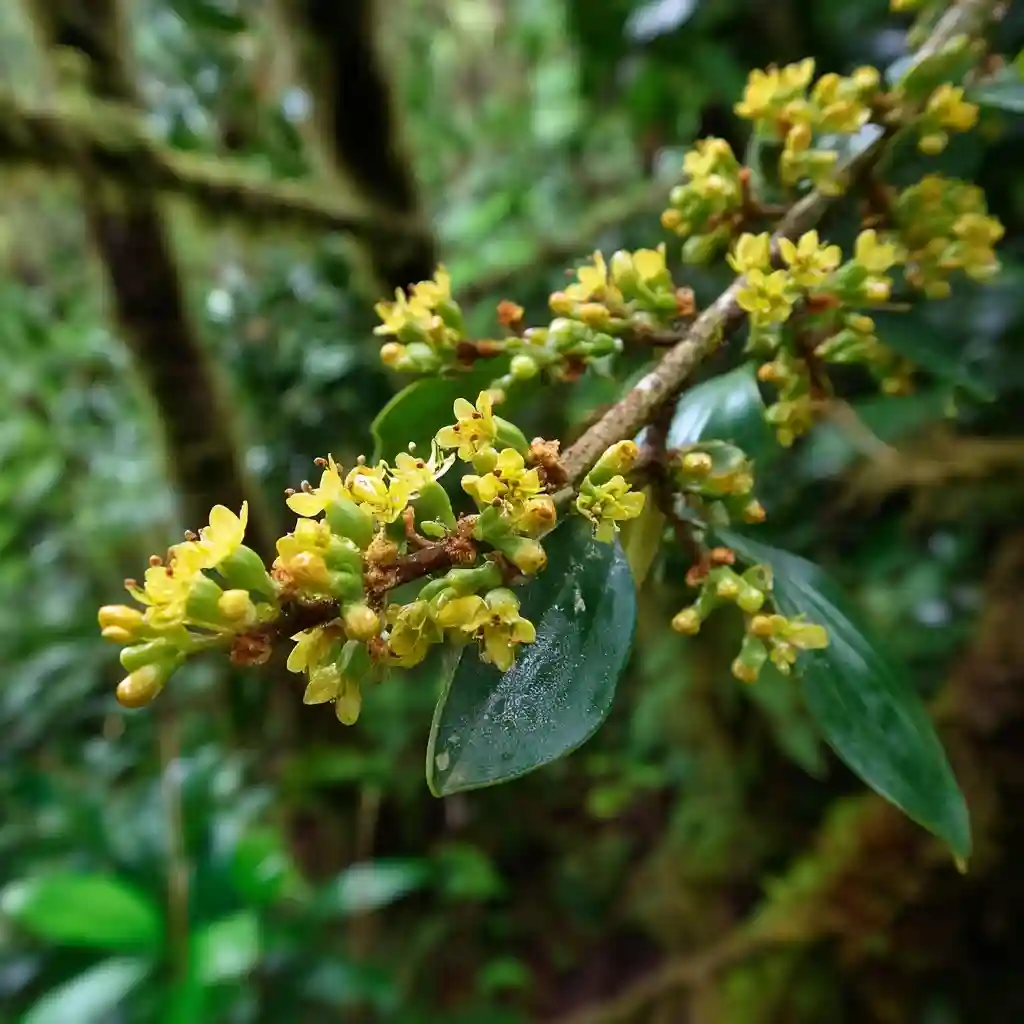
Broussaisia arguta, locally known as Kanawao, is a unique Hawaiian shrub that deserves a spot among the best Hawaiian flowers. Found primarily in wet and mesic forests across the islands, this native plant features clusters of small, greenish-yellow to purple flowers that eventually give way to striking blue fruits.
While its blossoms may be subtle compared to the flashy hibiscus or ʻŌhiʻa Lehua, Kanawao plays an important ecological role. Its flowers attract native insects, while the berries provide food for birds, making it a vital link in Hawaii’s forest ecosystems.
Gardeners interested in native Hawaiian landscaping value Broussaisia arguta for its lush foliage and ability to thrive in shaded, moist environments. Planting it in a tropical or woodland-style garden helps recreate the natural beauty of Hawaii’s rainforests while supporting local biodiversity.
11. Argyroxiphium sandwicense subsp. (Silversword)
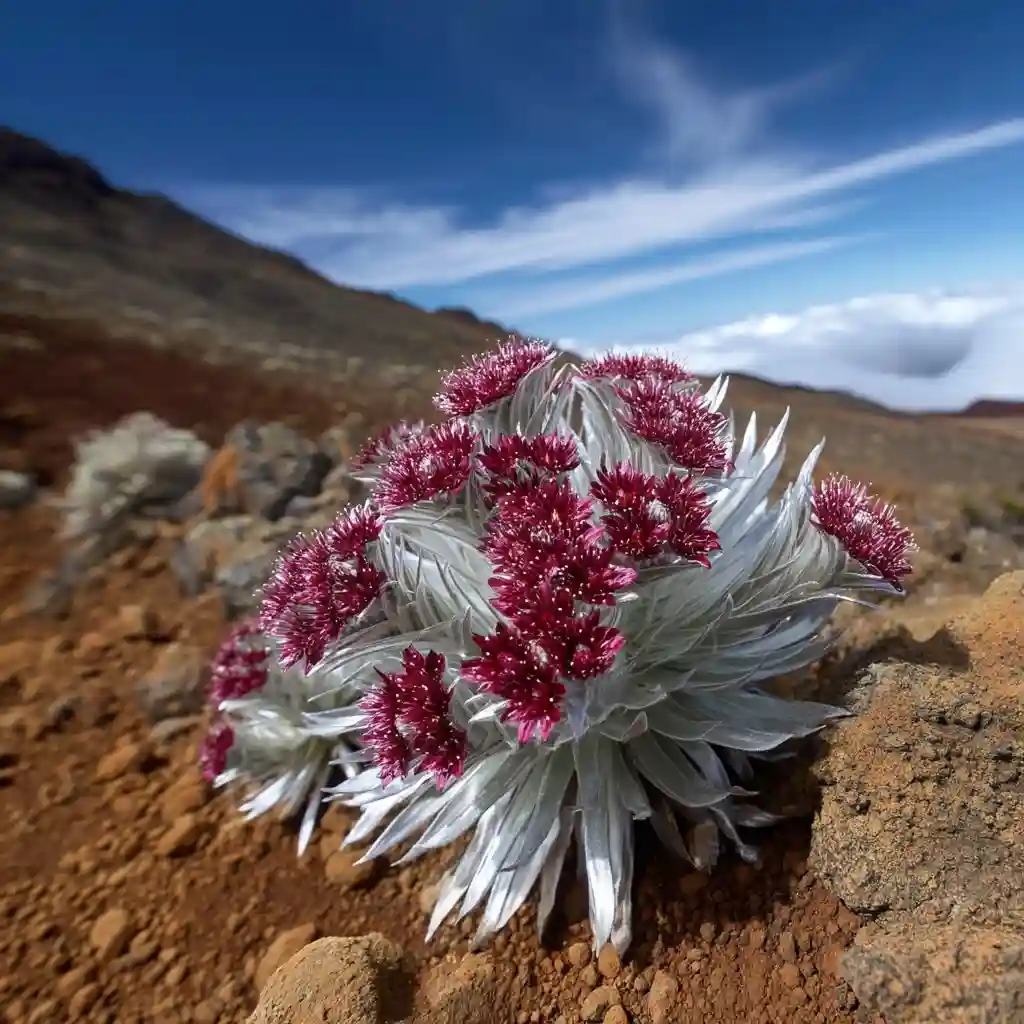
Argyroxiphium sandwicense, famously known as the Silversword, is one of the most extraordinary and best Hawaiian flowers. Found primarily on the high volcanic slopes of Haleakalā and Mauna Kea, this rare plant is instantly recognizable for its rosette of silvery, sword-like leaves that shimmer in the sunlight. When it blooms, a towering stalk covered in purple to maroon flowers rises dramatically, creating a sight unlike any other in the plant world.
The Silversword is specially adapted to survive harsh alpine conditions, including cold temperatures, intense sun, and limited water. Its slow growth and unique appearance have made it a symbol of Hawaii’s fragile alpine ecosystems.
Because it is endangered, the Silversword is protected in national parks, and cultivating it in home gardens is highly restricted. Visitors who encounter it in the wild are encouraged to admire it from a distance, helping ensure this remarkable species continues to thrive in its natural environment.
12. Lobelia gaudichaudii
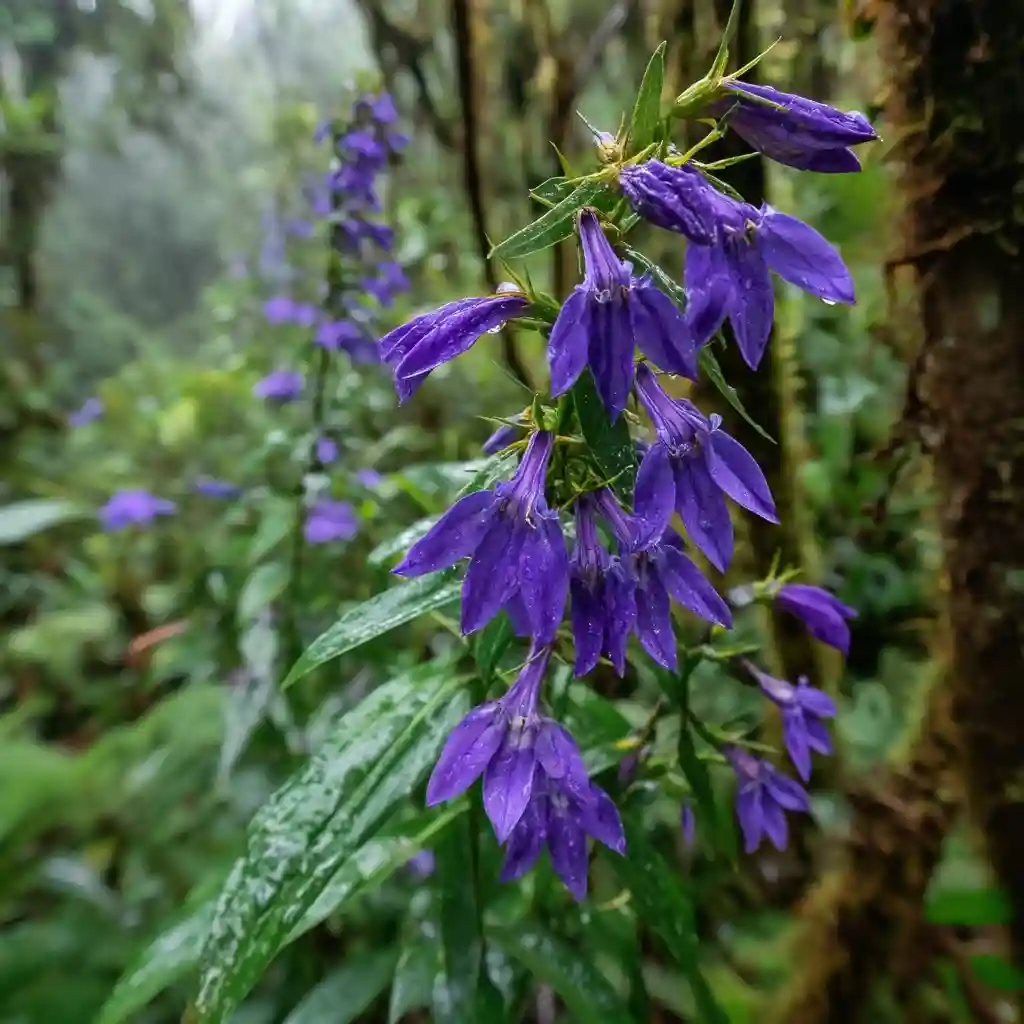
Lobelia gaudichaudii is a strikingly unique Hawaiian species that firmly belongs among the best Hawaiian flowers. This rare flowering plant is part of the bellflower family and produces long, tubular blooms in shades of purple or blue that hang gracefully from its tall, leafy stems.
Endemic to the islands, Lobelia gaudichaudii grows primarily in wet and mesic forests, often in remote upland areas. Its tubular flowers are perfectly adapted for pollination by Hawaiian honeycreepers, showcasing the incredible evolutionary relationships within Hawaii’s ecosystems.
While it is not commonly cultivated in home gardens due to its specialized habitat needs, Lobelia gaudichaudii plays a critical ecological role. Its beauty and rarity make it a prized sight for hikers and botanists exploring Hawaii’s native forests.
13. Leptecophylla tameiameiae (Pūkiawe)
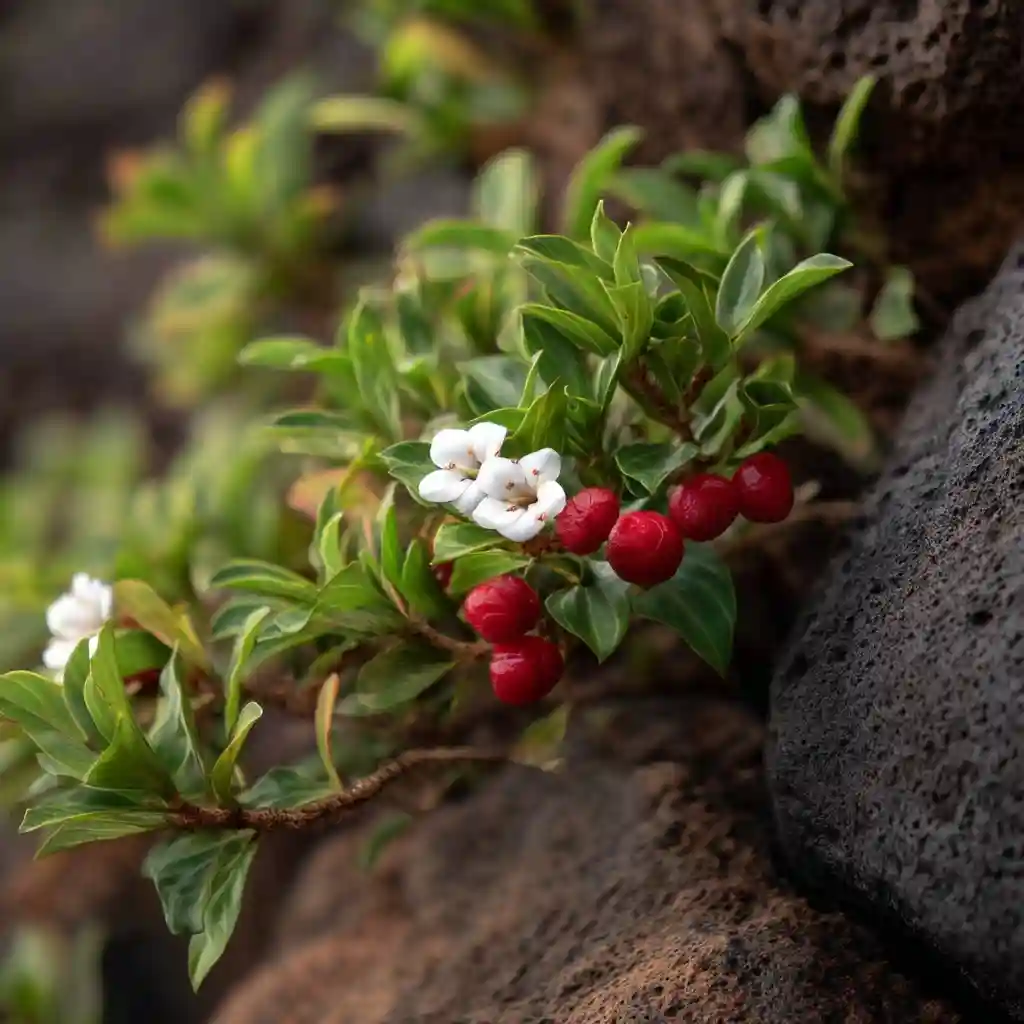
Leptecophylla tameiameiae, commonly known as Pūkiawe, is a hardy shrub that holds its place among the best Hawaiian flowers for its ecological importance and subtle beauty. While its flowers are small and often white or pinkish, they are followed by attractive red or purple berries that bring vibrant color to Hawaii’s landscapes.
This native plant thrives across a wide range of elevations, from coastal areas to alpine shrublands. Pūkiawe is particularly valued for its role in supporting native wildlife. Its berries provide food for Hawaiian birds, while the shrub itself helps stabilize soil in sensitive habitats.
For gardeners interested in native landscaping, Leptecophylla tameiameiae is a low-maintenance option that tolerates dry conditions and adds year-round interest with its berries and evergreen foliage. It’s a plant that embodies the quiet resilience of Hawaii’s native flora.
14. Anoectochilus sandvicensis (Hawaii Jewel Orchid)
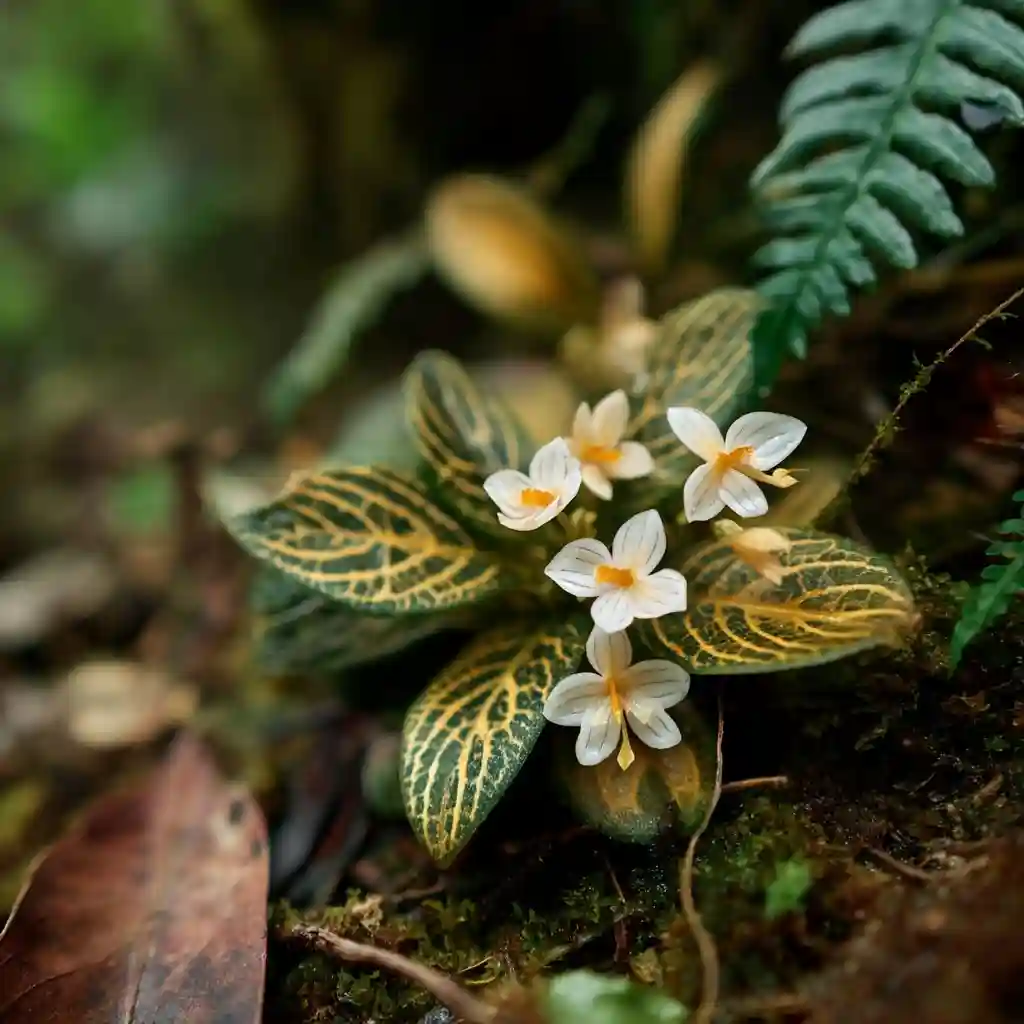
Anoectochilus sandvicensis, widely admired as the Hawaii Jewel Orchid, is a delicate and enchanting species that rightfully belongs among the best Hawaiian flowers. Unlike brightly colored tropical blooms, this orchid captivates with its deep green, velvety leaves accented by golden veins, while its small white flowers add an understated elegance.
This rare orchid is endemic to Hawaii and thrives in shaded, moist forest floors, often in higher elevation rainforests. Its beauty lies as much in its foliage as in its blossoms, making it a favorite for those who appreciate subtle, natural elegance.
Because of its specific habitat requirements, Anoectochilus sandvicensis is rarely cultivated successfully outside conservation efforts. Protecting its native environment is essential to ensure that this exquisite jewel continues to flourish in Hawaii’s forests.
15. Vaccinium reticulatum (‘Ōhelo)
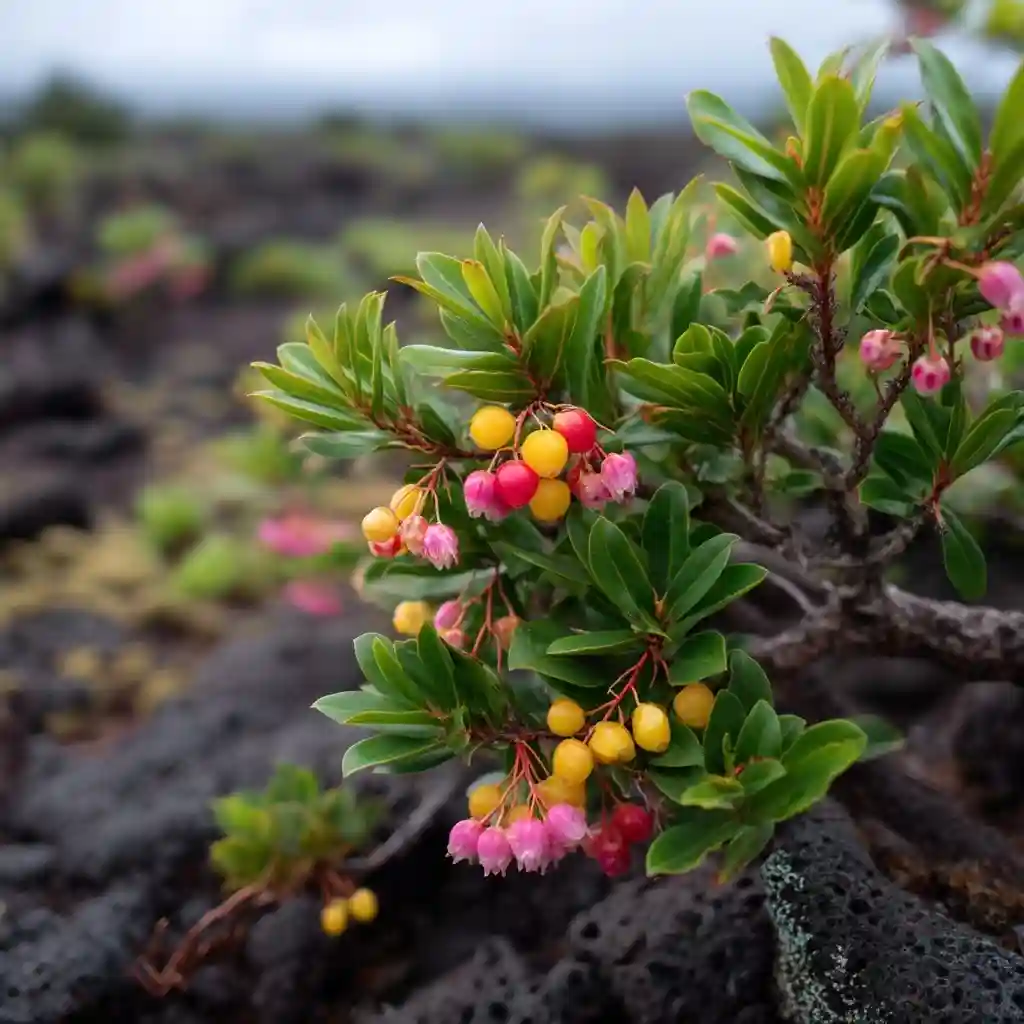
Vaccinium reticulatum, commonly known as ‘Ōhelo, is a small native shrub that earns its spot among the best Hawaiian flowers due to its vibrant blooms and edible berries. The plant features tiny pink to reddish flowers that later develop into bright red or yellow berries, which are not only visually striking but also culturally and ecologically significant.
In Hawaiian tradition, ‘Ōhelo berries were historically offered to the volcano goddess Pele before being eaten, symbolizing respect for the land and its natural gifts. Ecologically, these berries are an important food source for native birds such as the nēnē (Hawaiian goose).
For gardeners in suitable climates, ‘Ōhelo can be an attractive ornamental shrub, thriving in volcanic soils and sunny, well-drained locations. Its colorful flowers, cultural heritage, and wildlife value make it a special addition to any native Hawaiian landscape.
16. Dwarf Naupaka
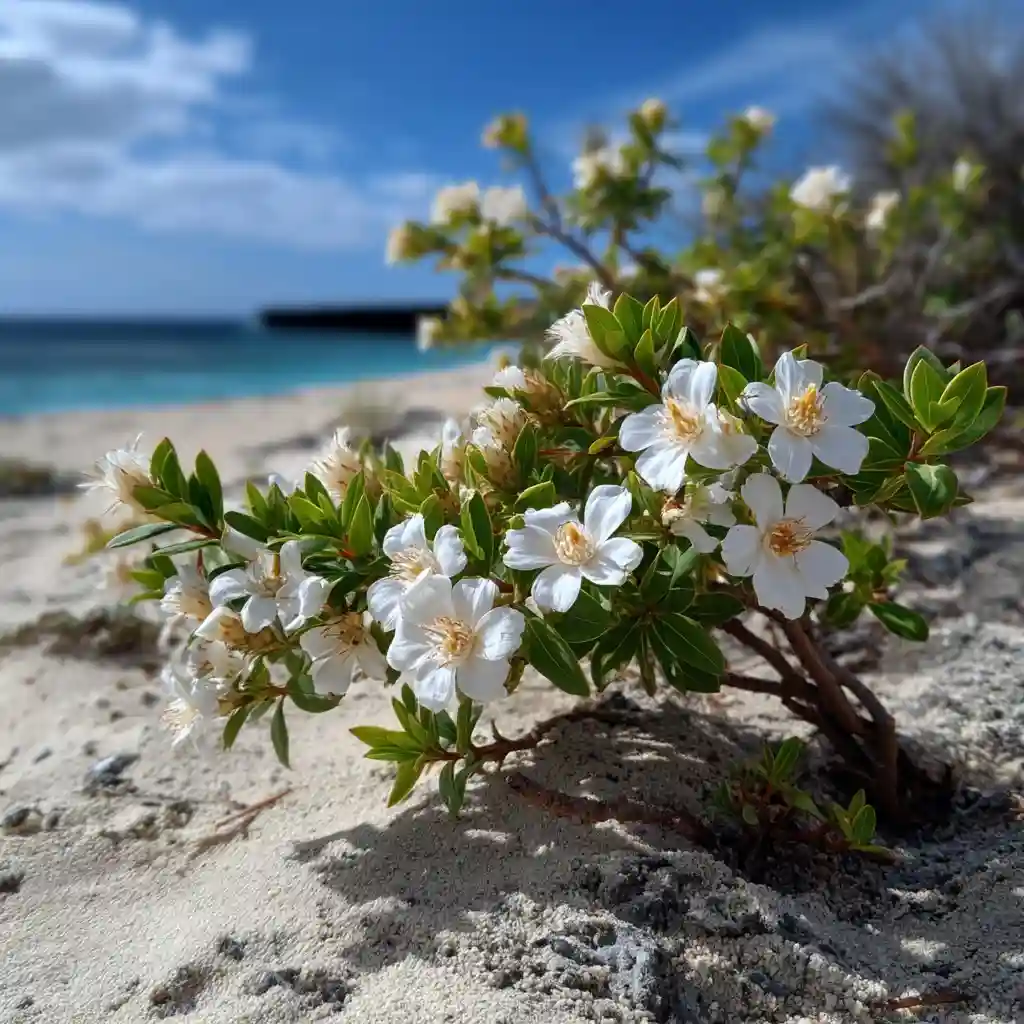
Dwarf Naupaka, a compact variety of the well-known Naupaka shrub, is a charming coastal plant that easily earns its place among the best Hawaiian flowers. Its unique half-petal white blooms have long fascinated locals and visitors alike, often tied to the Hawaiian legend of two lovers separated between the mountains and the sea.
This hardy plant thrives in sandy soils and salty, windy coastal environments, making it an essential part of Hawaii’s shoreline ecosystems. It not only provides ground cover that prevents erosion but also shelters small wildlife along the beaches.
Gardeners value Dwarf Naupaka for its resilience and low maintenance. It’s ideal for coastal or tropical-themed gardens where salt tolerance and ground stabilization are needed, all while adding a touch of Hawaiian cultural symbolism with its one-of-a-kind flowers.
17. Nanu or Na’u Gardenia
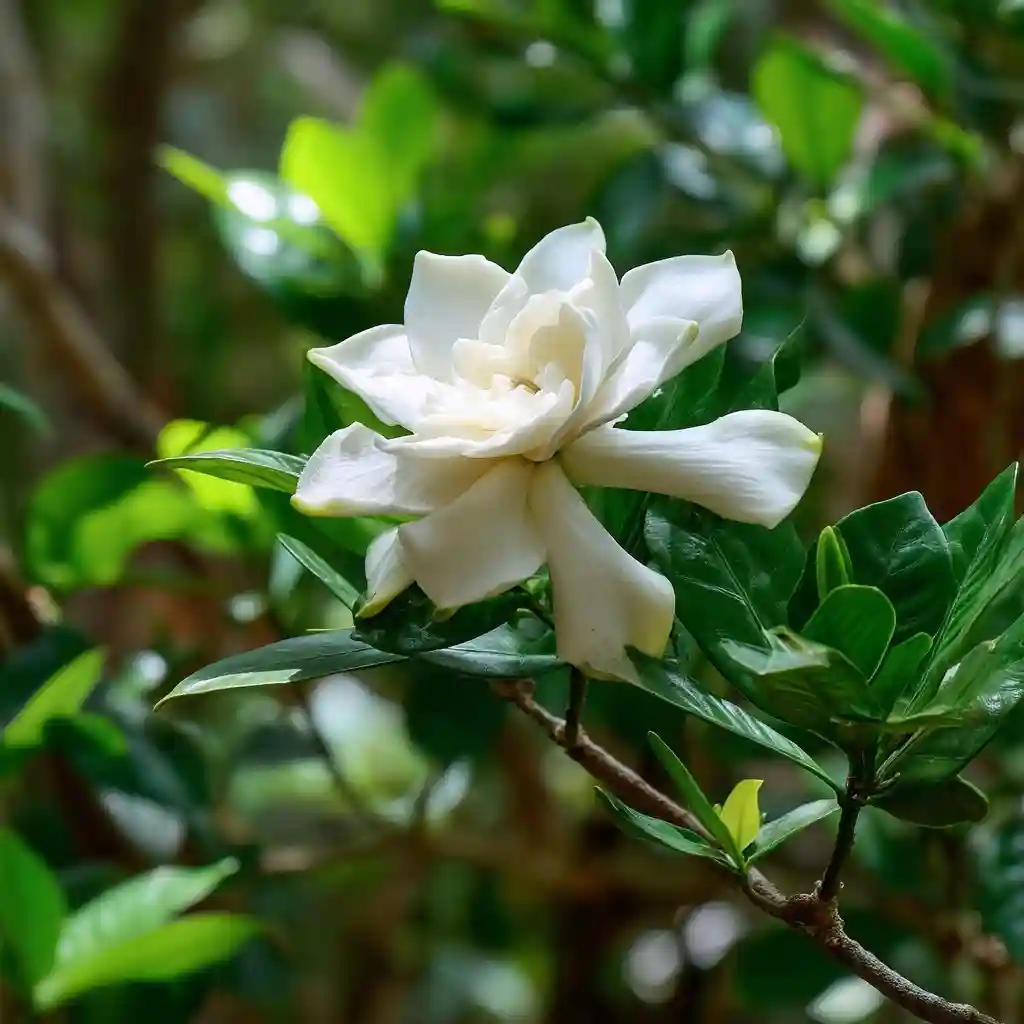
Nanu (or Na’u) Gardenia, scientifically known as Gardenia brighamii, is a fragrant native shrub that truly belongs among the best Hawaiian flowers. Its creamy white blossoms release a sweet perfume, making it a cherished ornamental and cultural plant throughout the islands.
This rare gardenia once thrived across dry forests in Hawaii but is now considered endangered due to habitat loss. Its glossy green leaves and pristine white flowers attract native insects, while its scent makes it a favorite for leis and traditional uses.
For gardeners, Nanu Gardenia prefers full sun to partial shade and well-drained soil. Though it requires some care, its beauty and fragrance are unmatched, bringing the essence of Hawaiian flora to cultivated landscapes while honoring the islands’ botanical heritage.
18. Moloka’i White Hibiscus
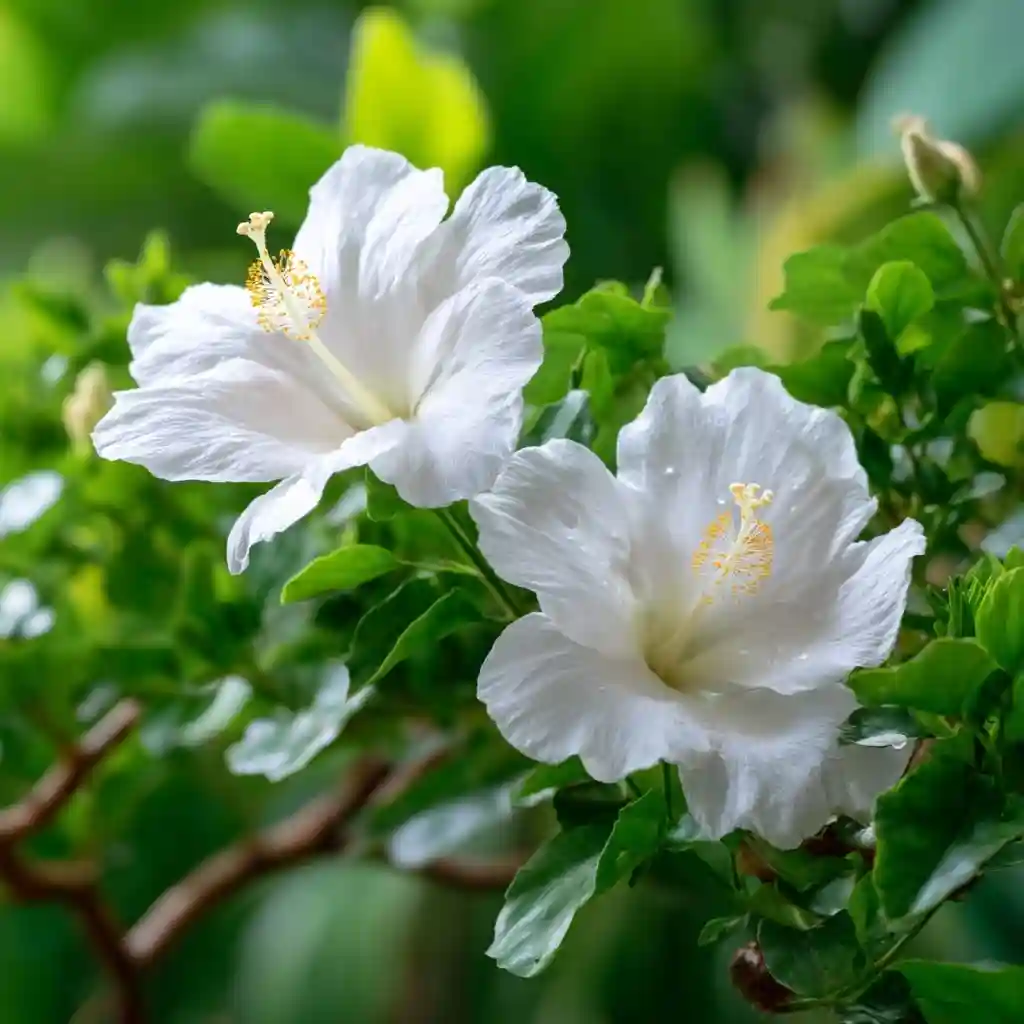
Moloka’i White Hibiscus, a rare variety of Hibiscus arnottianus, is a striking native flower that secures its spot among the best Hawaiian flowers. Its large, pure white petals with a touch of pink at the base and prominent red stamens make it a showstopper in any tropical setting.
Endemic to Moloka’i and O‘ahu, this hibiscus species thrives in moist valleys and lowland forests. Unlike many other hibiscus varieties, it has a light, pleasant fragrance that enhances its ornamental appeal.
Gardeners who wish to cultivate Moloka’i White Hibiscus should provide it with full sun, ample water, and well-draining soil. Its luminous blossoms not only beautify gardens but also help preserve Hawaii’s native floral legacy when grown responsibly.
19. Dwarf White Hibiscus
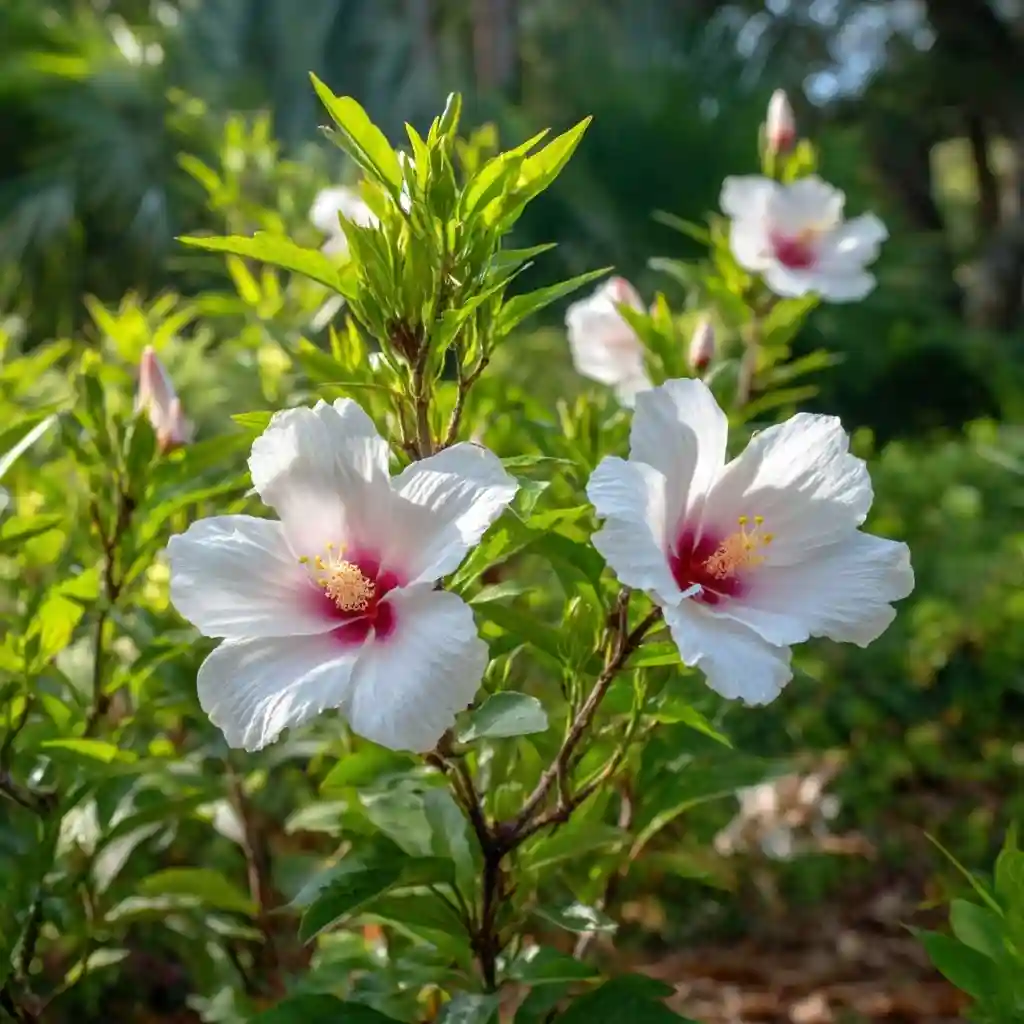
Dwarf White Hibiscus is a compact and charming native shrub that earns its place among the best Hawaiian flowers. With its small stature and pristine white blooms accented by striking red stamens, this variety is perfect for adding elegance to smaller garden spaces or as a border plant in tropical landscapes.
Unlike larger hibiscus species, the Dwarf White Hibiscus is easier to manage and thrives in sunny locations with well-drained soil. Its delicate flowers attract pollinators like butterflies and bees, contributing to the ecological health of Hawaiian gardens.
Gardeners value this plant for both its ornamental appeal and low maintenance needs. By incorporating Dwarf White Hibiscus into a native or tropical garden, you get a continuous display of classic Hawaiian beauty in a compact form.
20. Koki’o ‘Ula
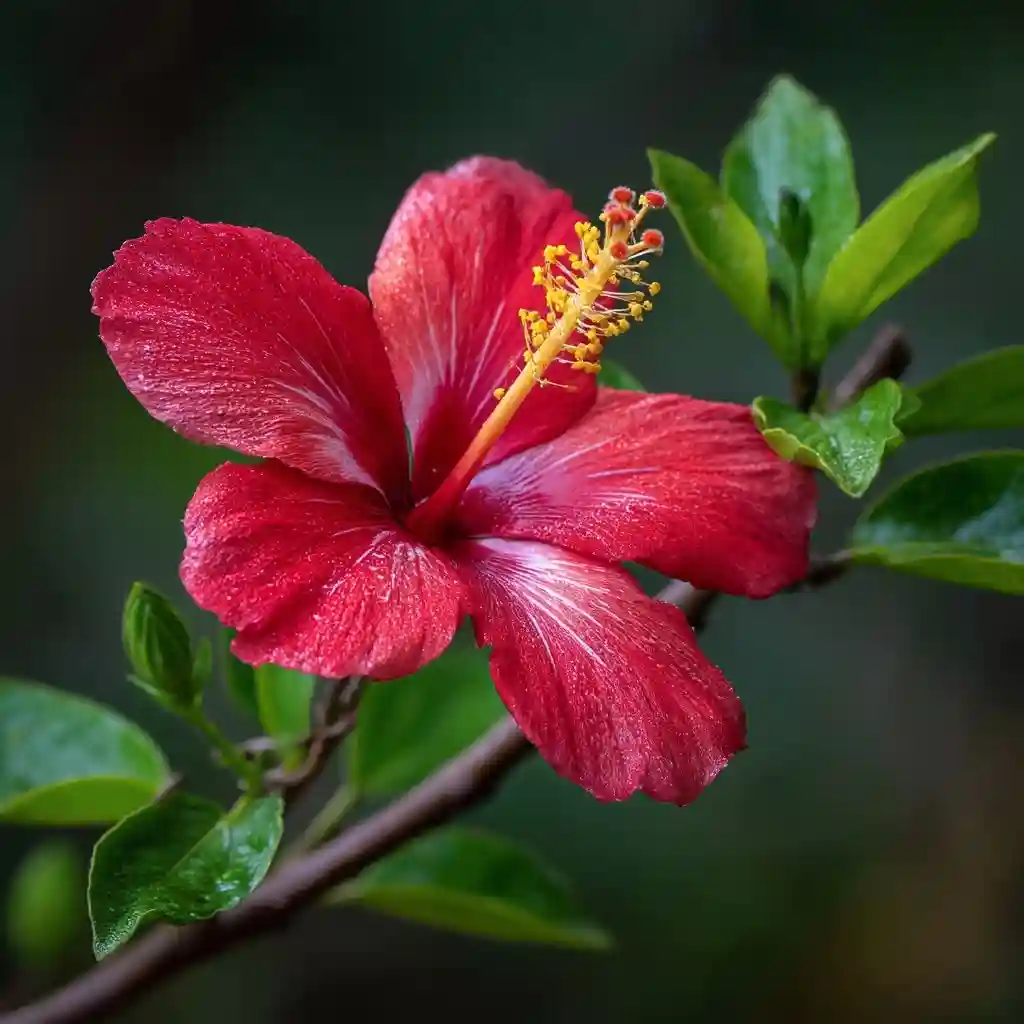
Koki’o ‘Ula, scientifically known as Hibiscus kokio, is a brilliant red hibiscus that stands proudly among the best Hawaiian flowers. Its fiery crimson petals and vibrant yellow stamens make it one of the most visually striking native flowers in Hawaii.
Endemic to the Hawaiian Islands, Koki’o ‘Ula typically thrives in dry to mesic forests, where its bold blooms attract native pollinators, including honeycreepers. Its presence in the wild is a testament to the resilience and beauty of Hawaii’s natural landscapes.
For home gardens, Koki’o ‘Ula is a favorite for adding a splash of tropical color. It flourishes in sunny spots with well-drained soil and benefits from regular watering. Planting this native hibiscus not only enhances visual appeal but also supports local wildlife and conservation efforts.
21. Red ‘Ilima
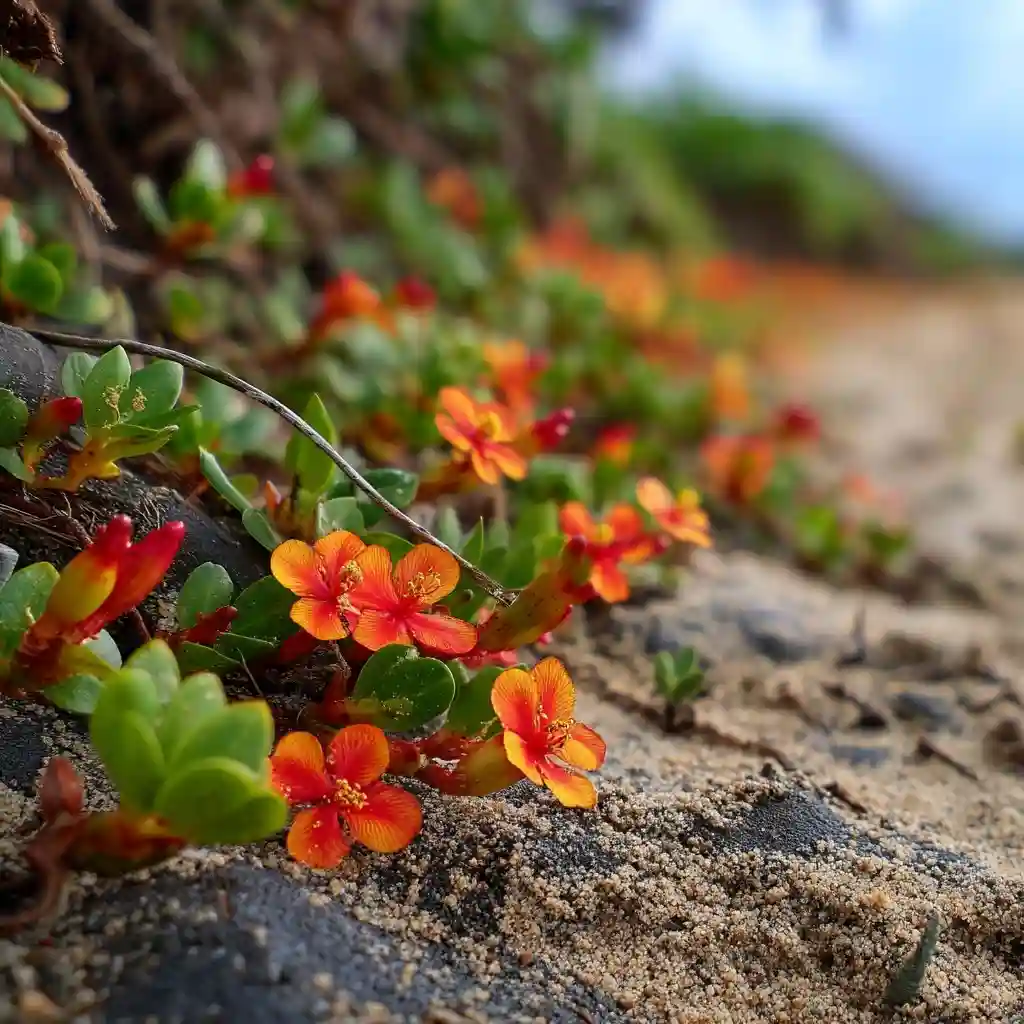
Red ‘Ilima, known scientifically as Sida fallax, is a small yet culturally significant flower that secures its spot among the best Hawaiian flowers. This groundcover plant produces delicate, reddish-orange blossoms that have long been used in traditional Hawaiian lei making.
Native to coastal and dry lowland areas, Red ‘Ilima is highly resilient and thrives in sandy soils, salty winds, and sunny conditions. Its understated beauty and durability make it a natural choice for stabilizing dunes and adding color to shoreline landscapes.
Gardeners appreciate Red ‘Ilima not just for its ornamental value, but also for its cultural importance. Planting it in a coastal garden or xeriscape supports native pollinators while preserving a living link to Hawaii’s rich traditions.
22. Hawaii Tree Cotton
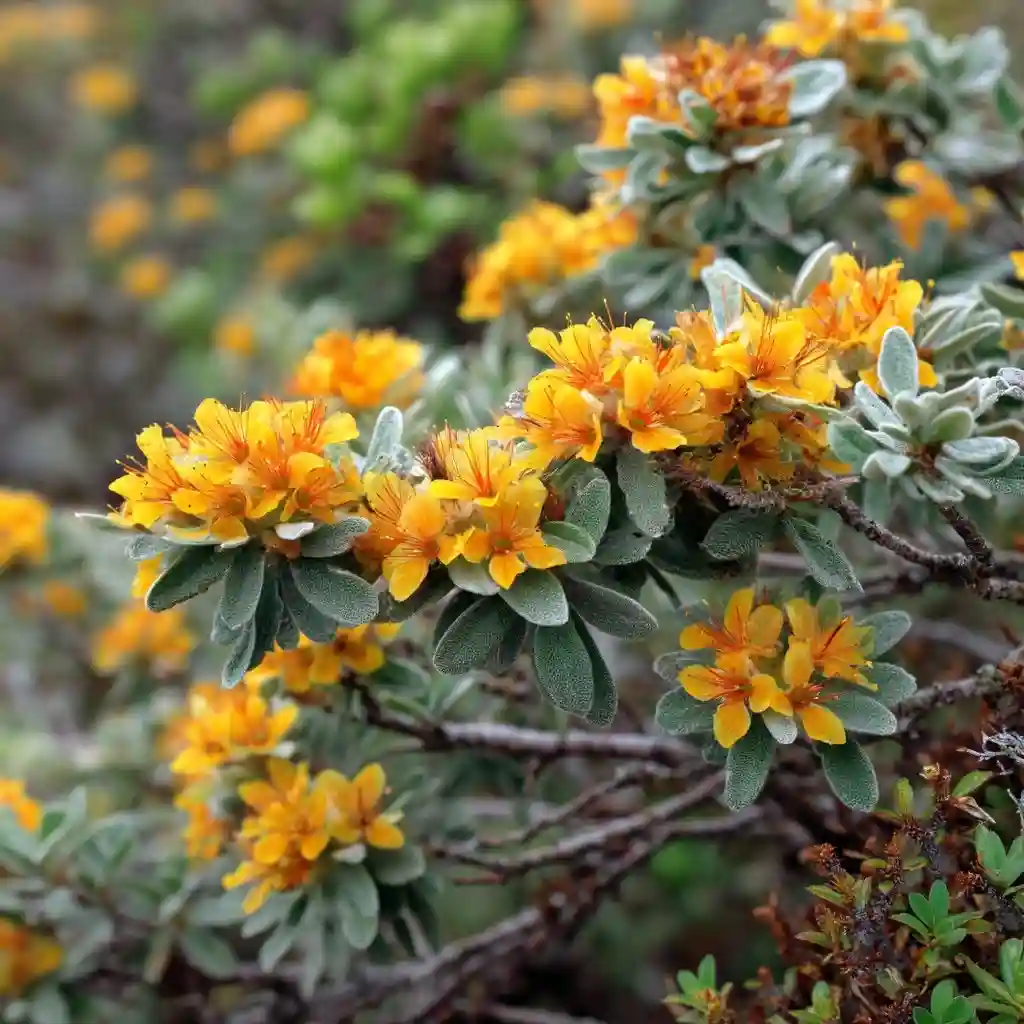
Hawaii Tree Cotton, scientifically known as Gossypium tomentosum, is a unique native species that rightfully belongs among the best Hawaiian flowers. Unlike the cultivated cotton varieties familiar worldwide, this plant features bright yellow flowers that age to a deep maroon, creating a striking color transition.
Endemic to dry, coastal regions of the Hawaiian Islands, Hawaii Tree Cotton is drought-tolerant and thrives in sandy, well-drained soils. Its soft, silvery leaves and showy blooms make it both a practical and ornamental choice for xeriscaping or native gardens.
Beyond its visual appeal, the plant is culturally and ecologically significant. Its cotton fibers were historically used in traditional Hawaiian practices, and its flowers provide nectar for native insects. Adding Hawaii Tree Cotton to a landscape combines low maintenance with authentic Hawaiian character.
23. Pua ‘Ala
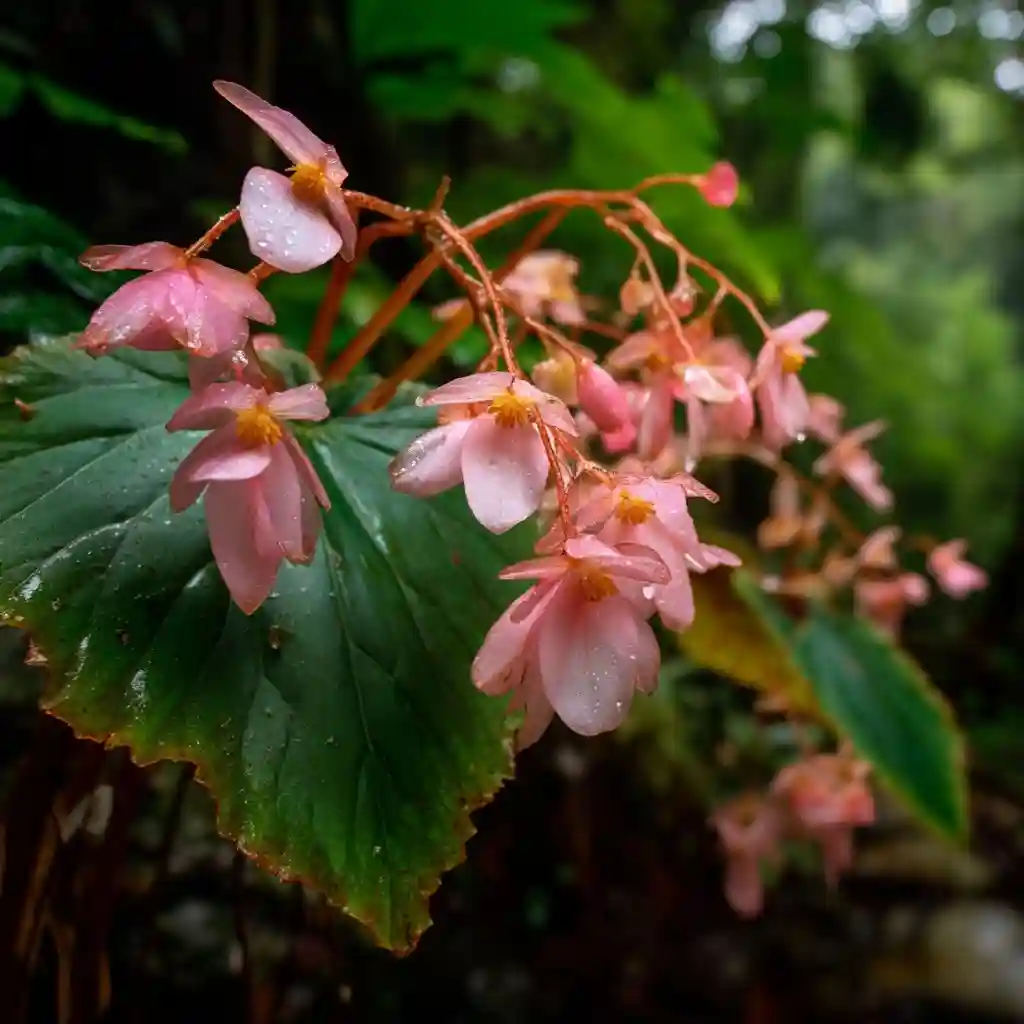
Pua ‘Ala, also known as Cyanea angustifolia, is a rare and captivating native plant that earns its spot among the best Hawaiian flowers. This member of the bellflower family produces long, tubular purple to blue blooms that dangle elegantly from its stems, creating a distinctive, tropical look.
Found in mesic to wet forests, Pua ‘Ala thrives in shaded environments where moisture is consistent. Its tubular flowers are perfectly adapted for pollination by native birds such as honeycreepers, highlighting the intricate ecological connections of Hawaiian flora.
While difficult to cultivate outside its native habitat, protecting Pua ‘Ala in the wild is critical to preserving Hawaii’s biodiversity. Its beauty and ecological role make it a true treasure of the islands’ natural heritage.
Conclusion
The best Hawaiian flowers are more than just beautiful blooms—they are living symbols of Hawaii’s natural and cultural heritage. From the vibrant Koki’o ‘Ula and fragrant Nanu Gardenia to the rare Silversword and delicate Hawaii Jewel Orchid, each flower tells a story of resilience and connection to the islands’ ecosystems.
By appreciating and, when possible, cultivating native species, we not only enhance the beauty of our gardens but also support pollinators, preserve biodiversity, and honor the deep traditions of Hawaii. Whether you encounter these flowers in the wild or in a thoughtfully designed landscape, they offer a timeless reminder of the islands’ unique botanical treasures.
FAQs
1. Which Hawaiian flower is best for home gardens?
Hibiscus varieties like Koki’o ‘Ula and Dwarf White Hibiscus are ideal for home gardens because they are vibrant, hardy, and attract pollinators.
2. Are all native Hawaiian flowers endangered?
No, but several species—like Brighamia insignis and Silversword—are endangered and should not be picked or removed from their habitats.
3. Can I grow Hawaiian flowers outside Hawaii?
Some, like Hibiscus and Naupaka, can thrive in tropical or subtropical climates. However, rare species often require specific conditions and may be protected by law.
4. What is the most culturally significant Hawaiian flower?
The Hibiscus (state flower) and Red ‘Ilima are highly valued in Hawaiian culture, especially in lei making and traditional ceremonies.
🌿 Love gardening inspiration? Follow me on Pinterest for bold plant ideas, tips, and seasonal color!
More Posts
